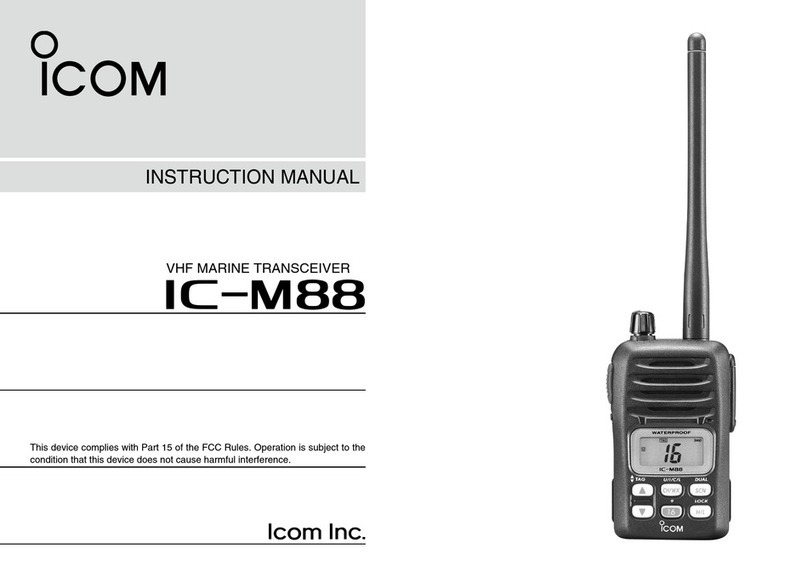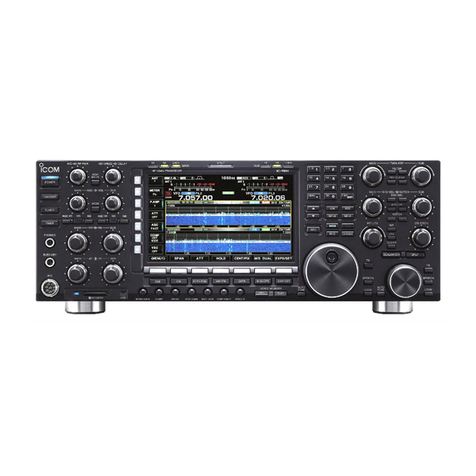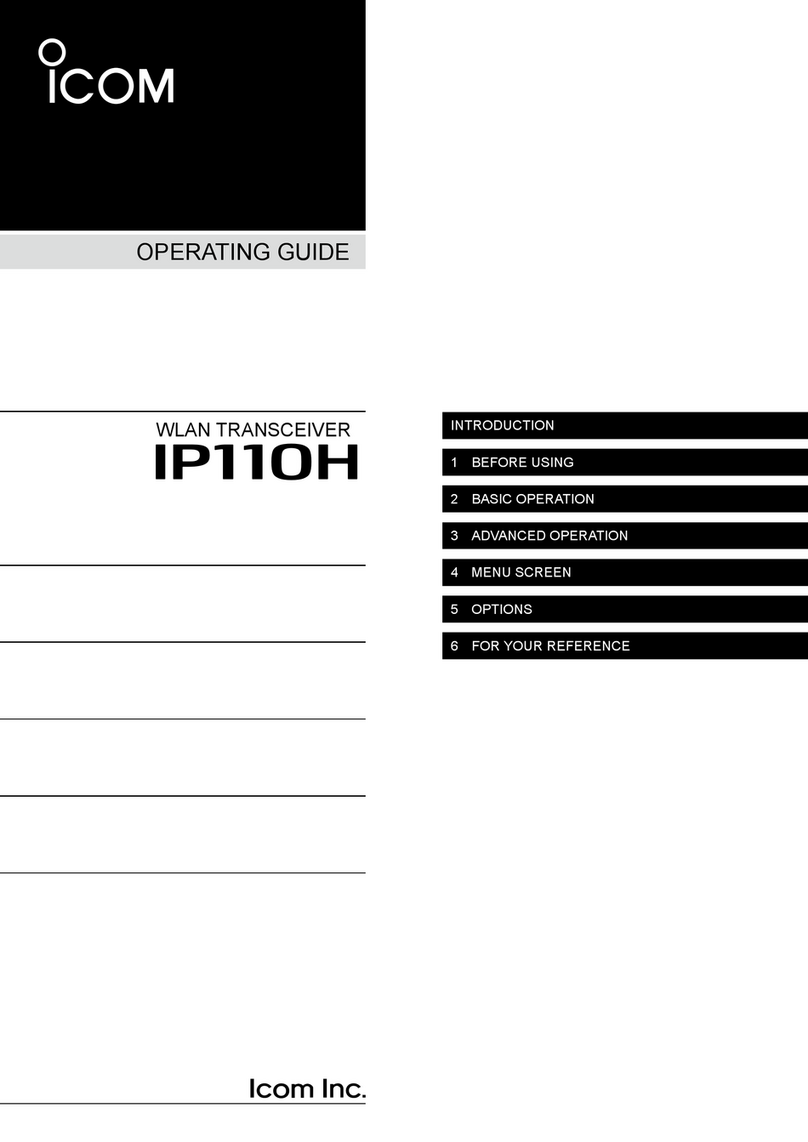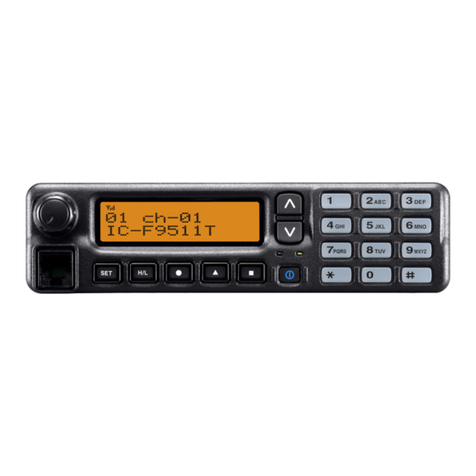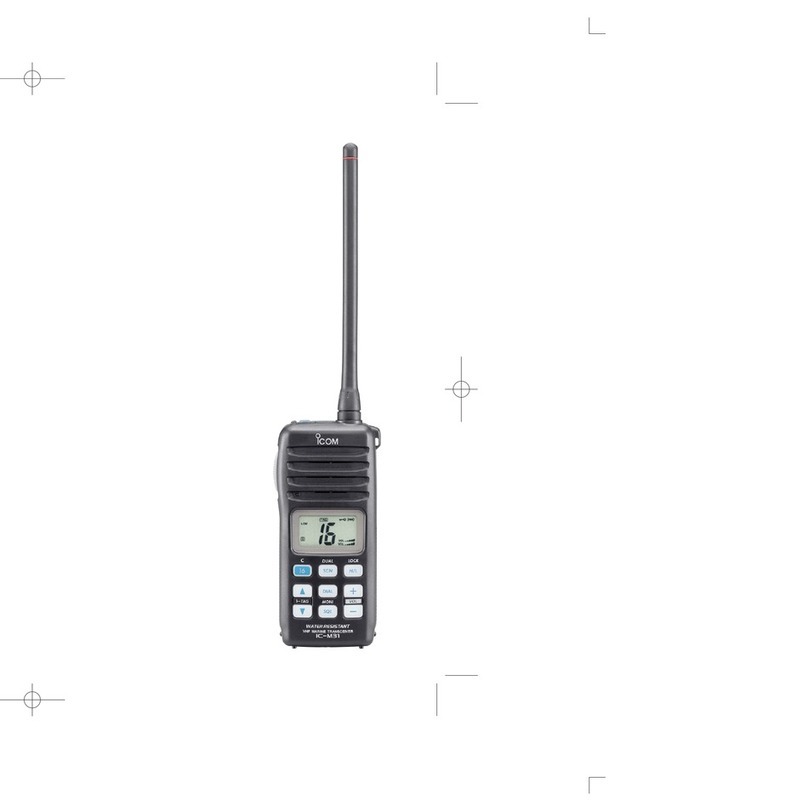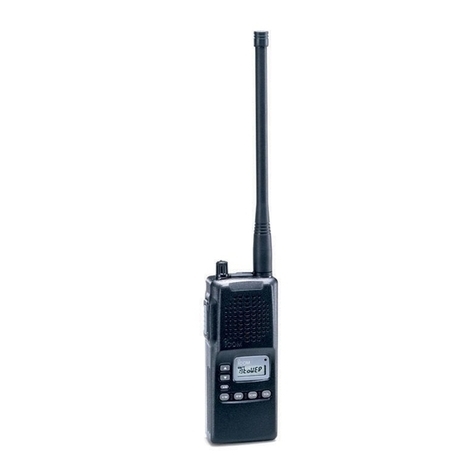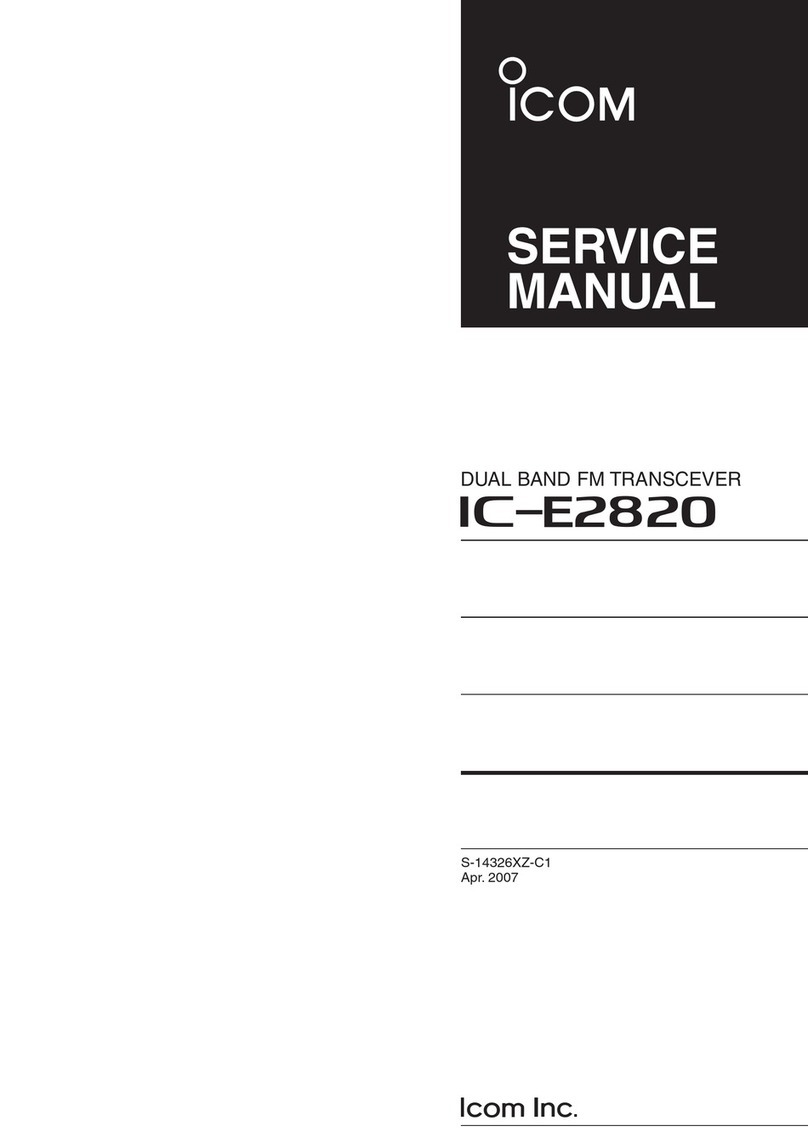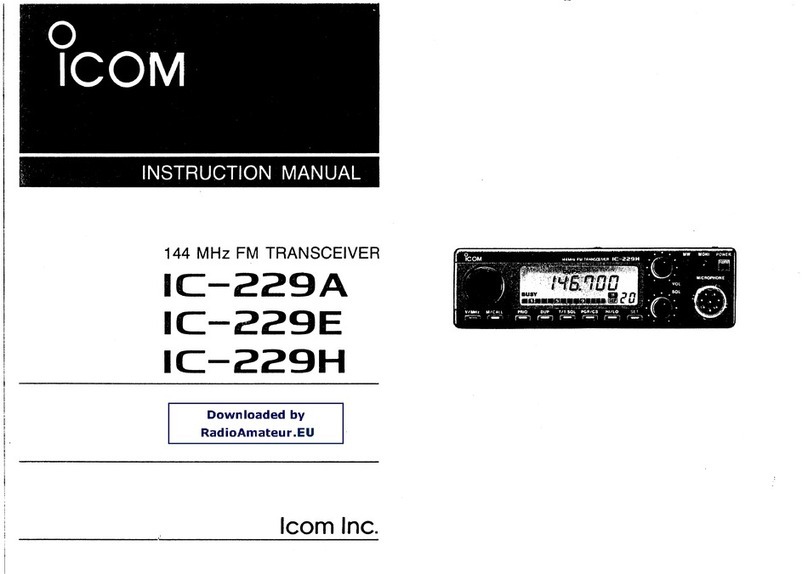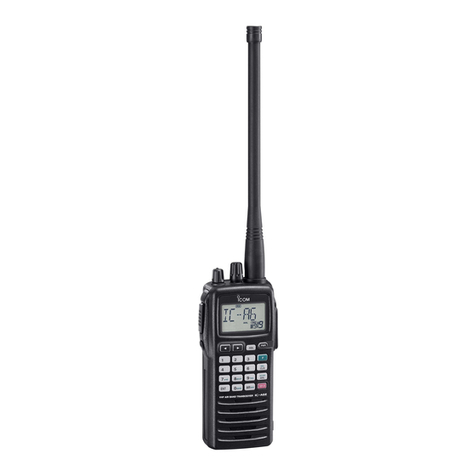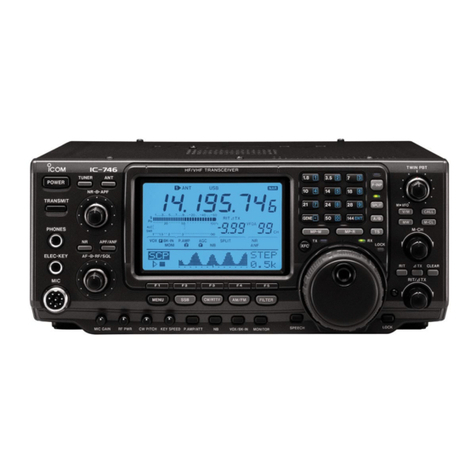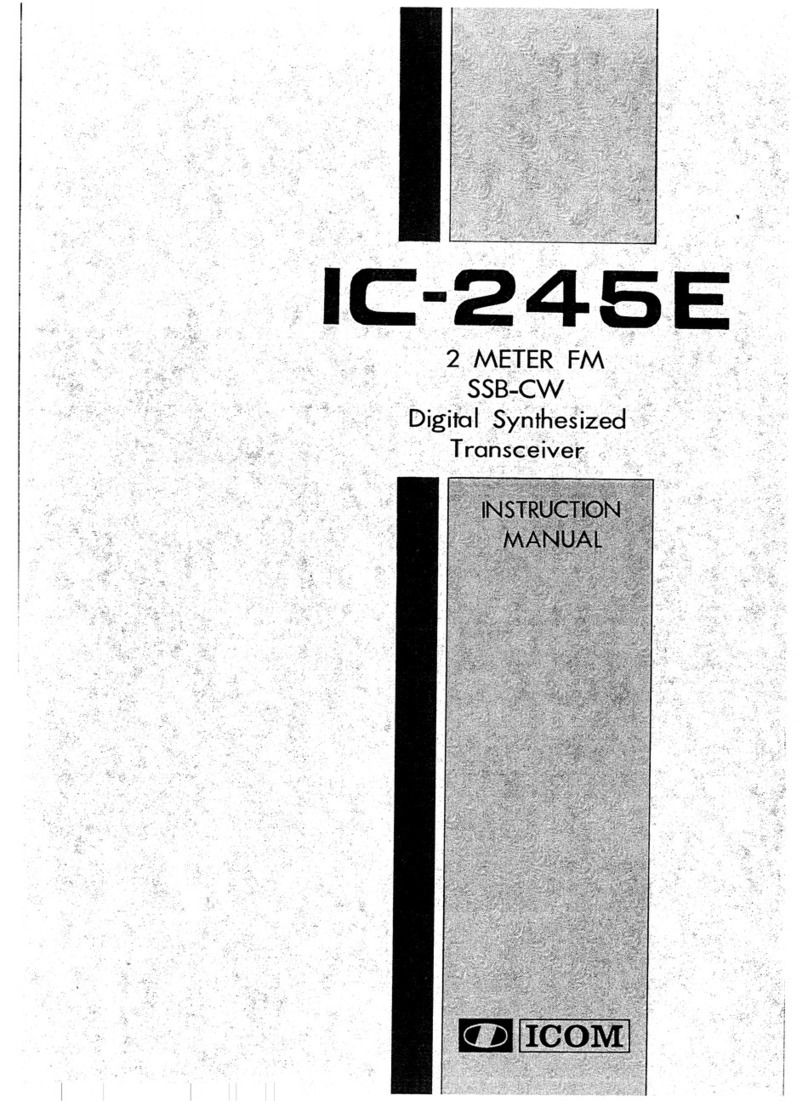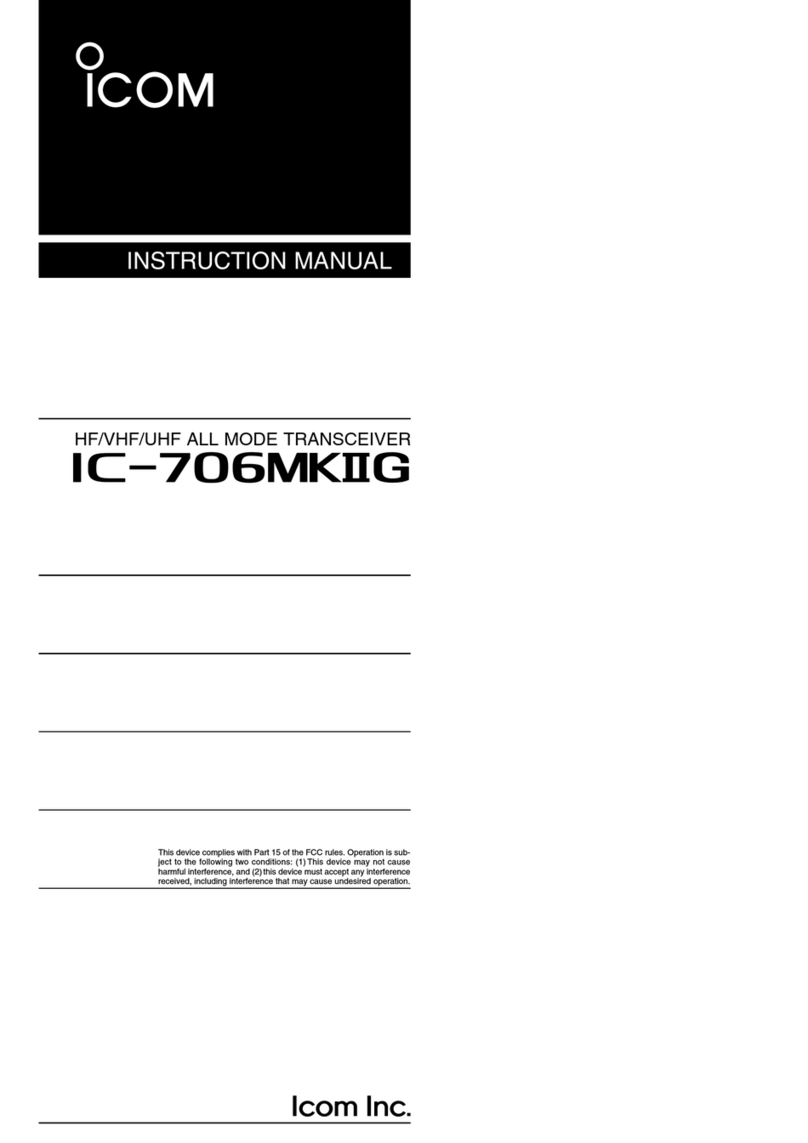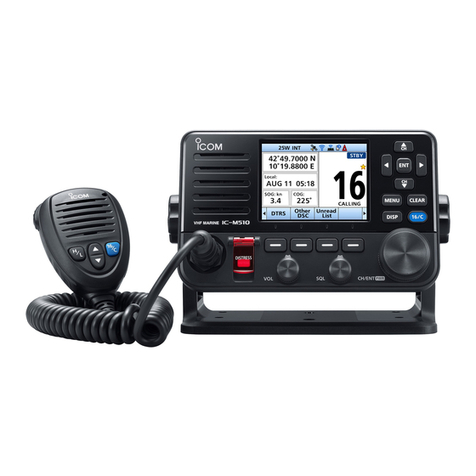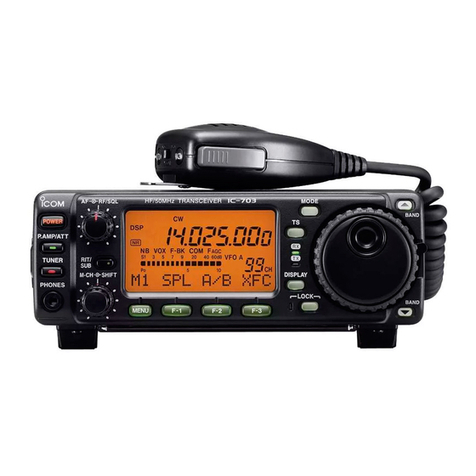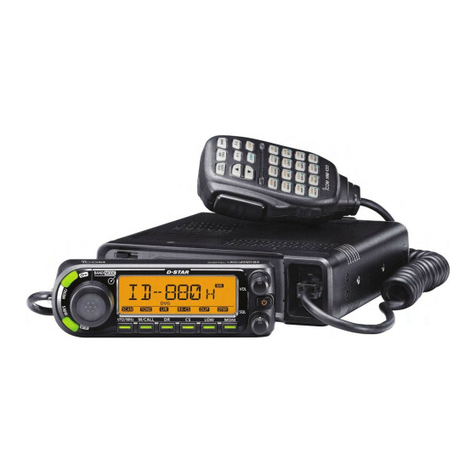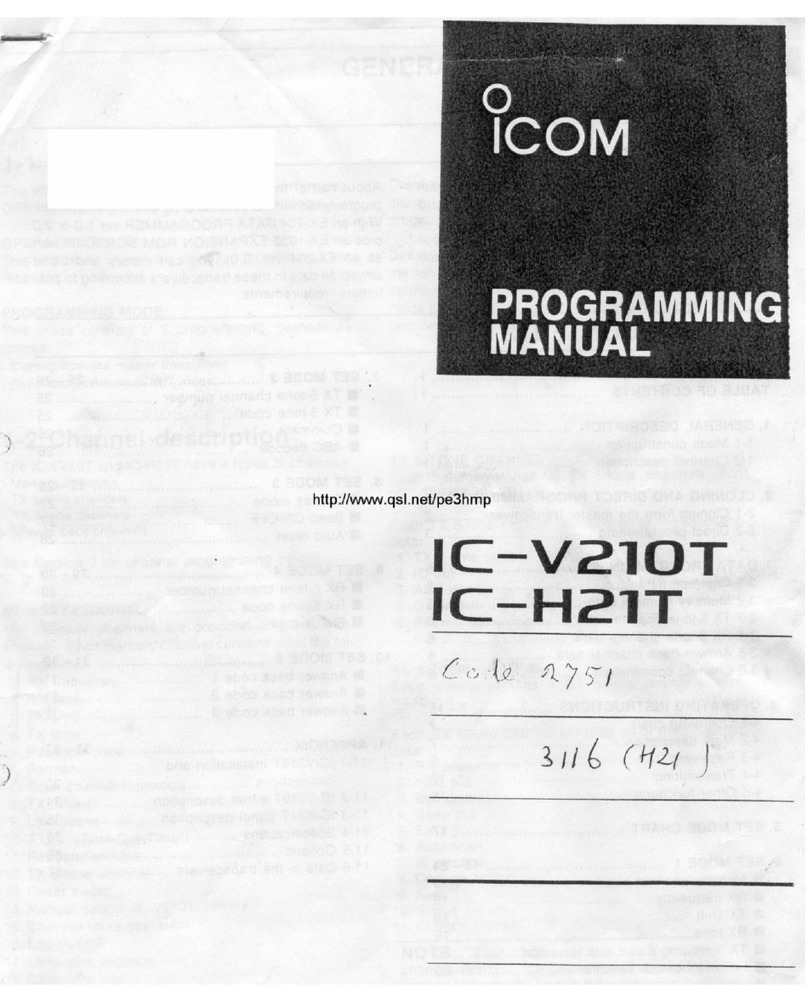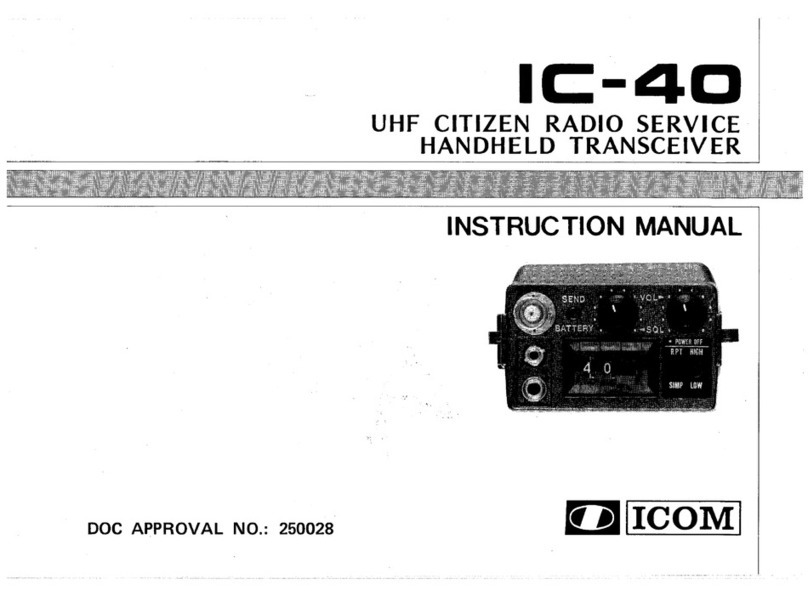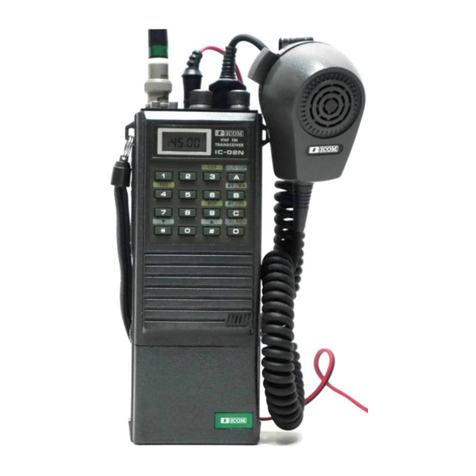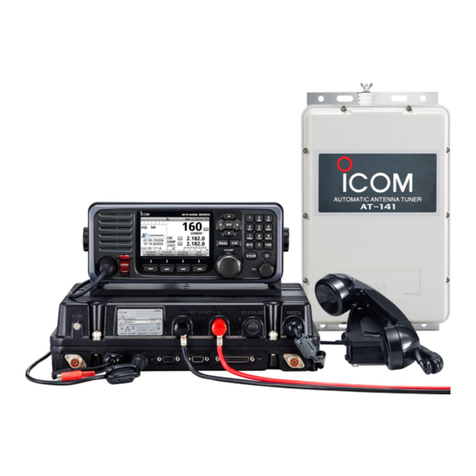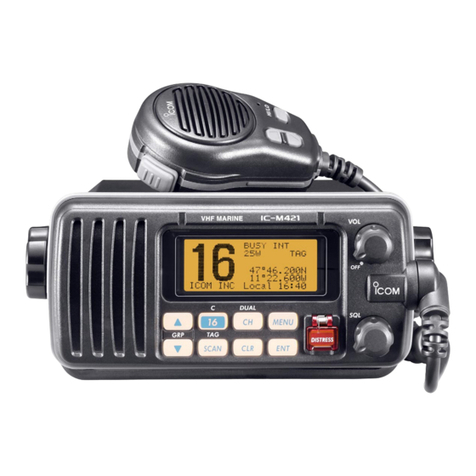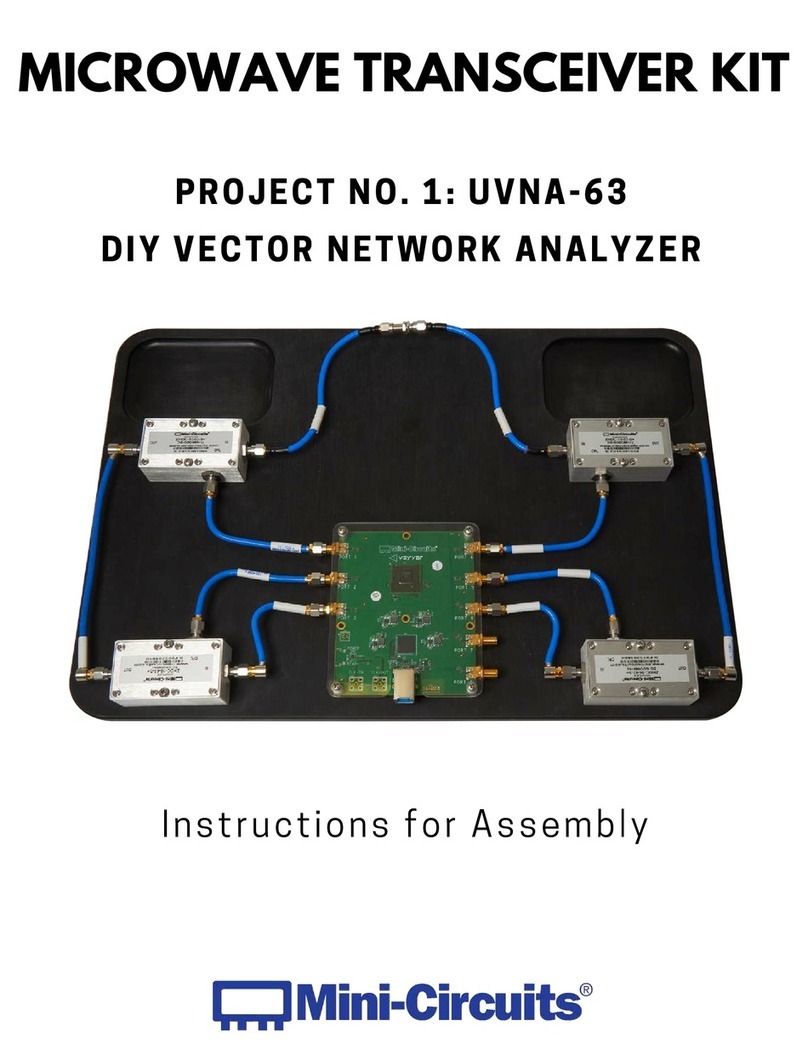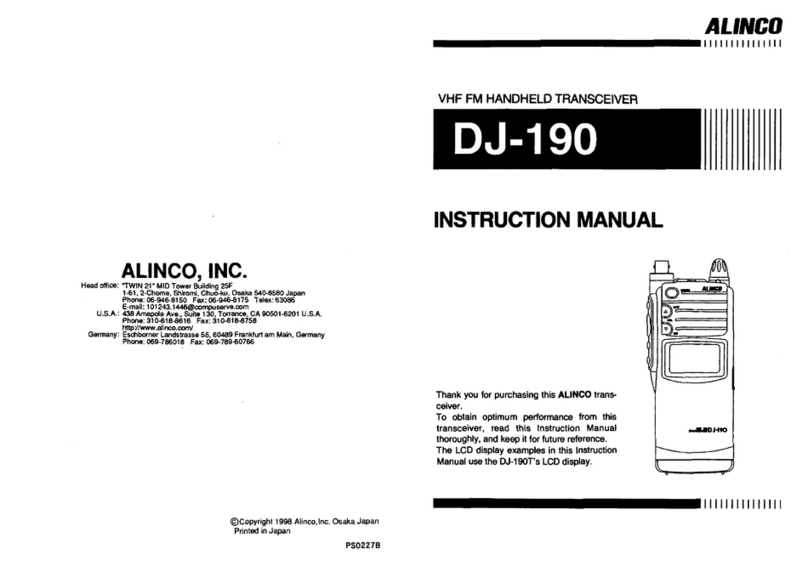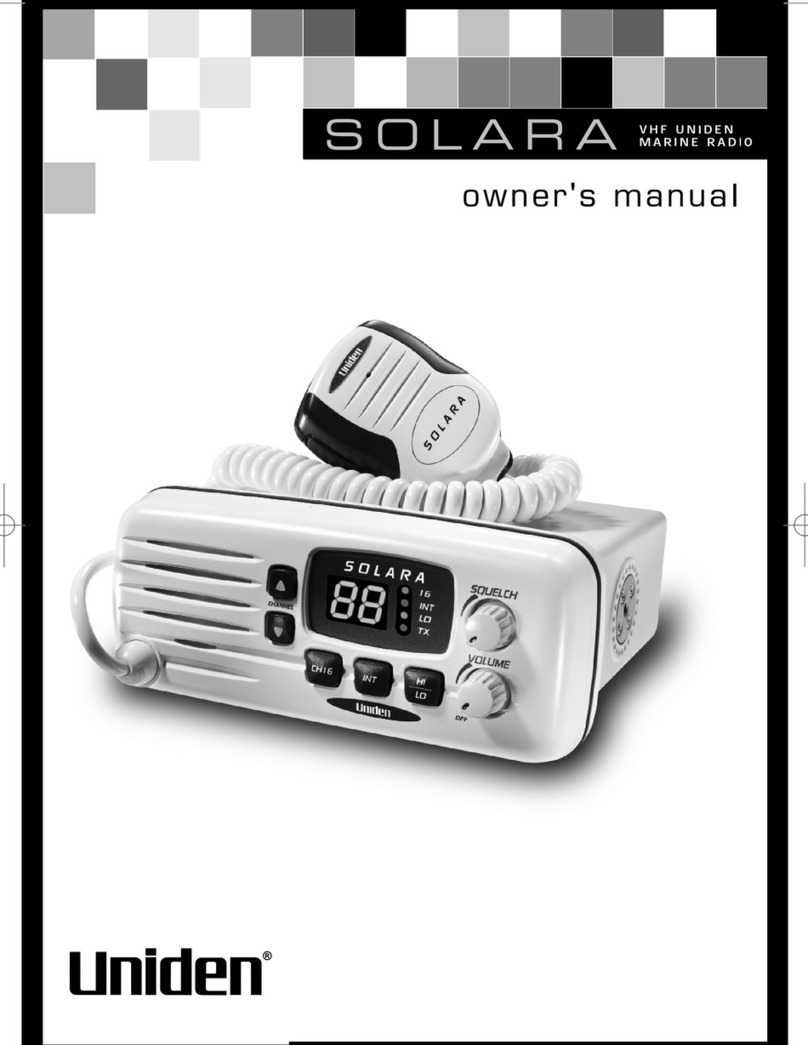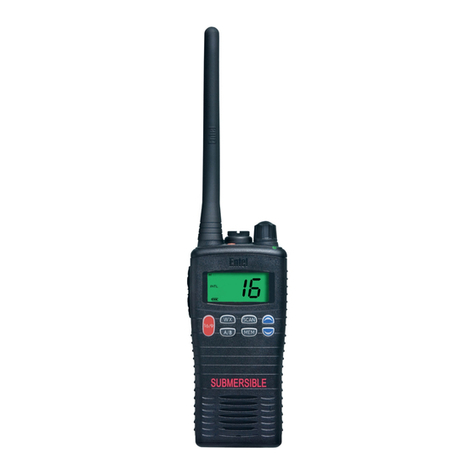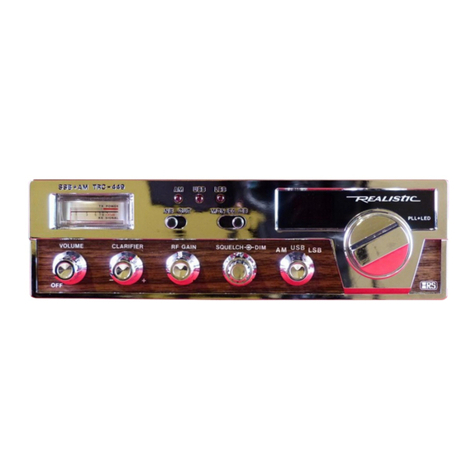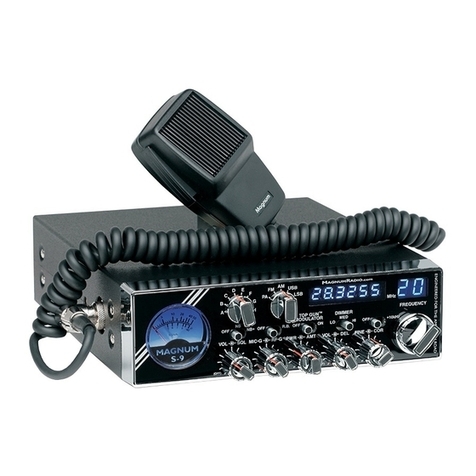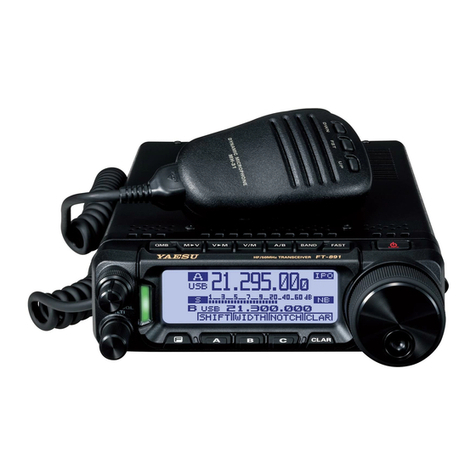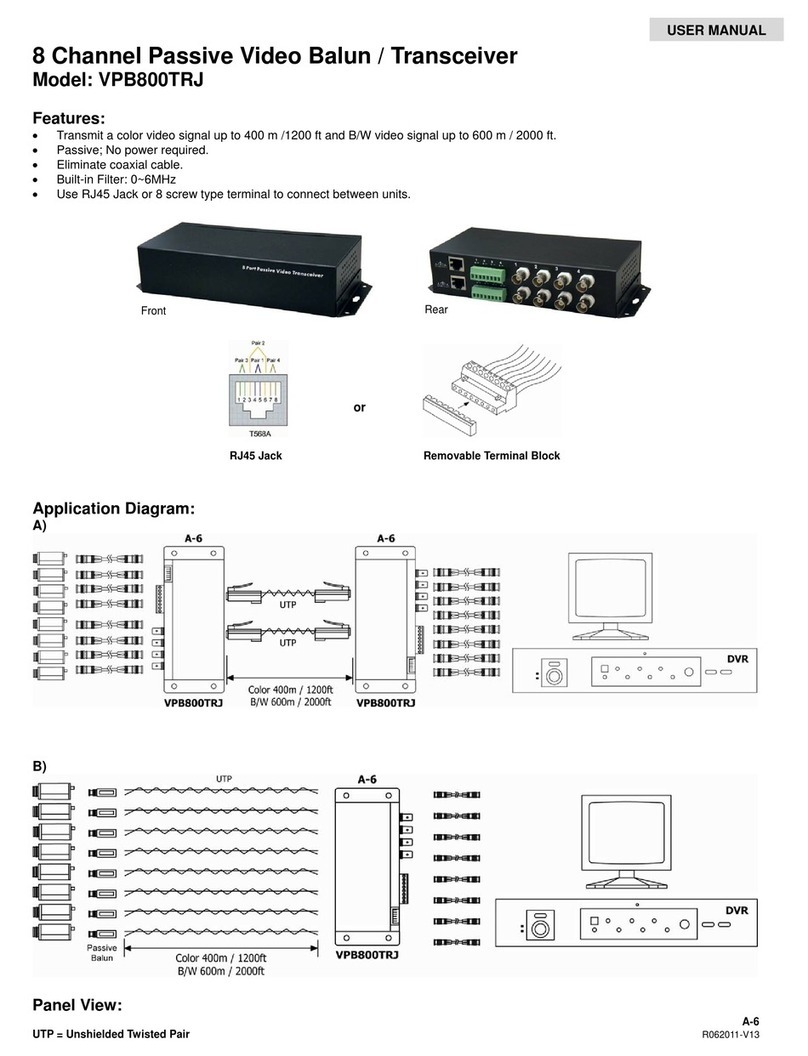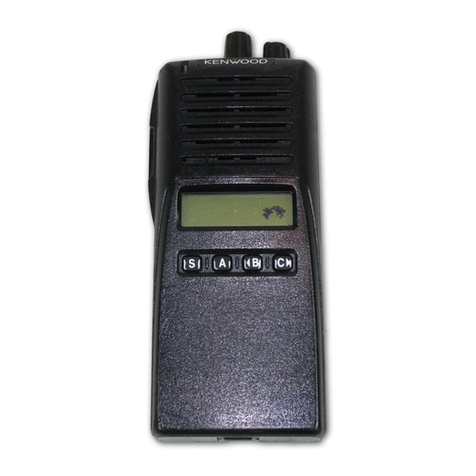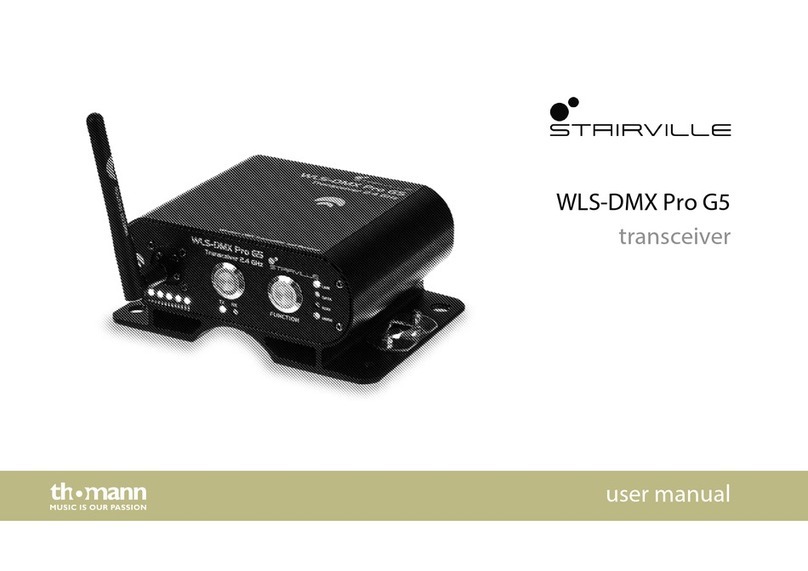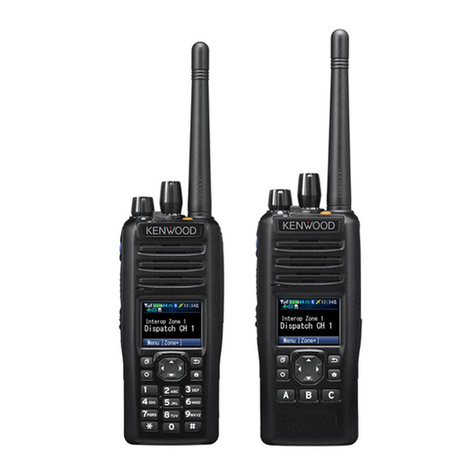Icom IC-F4101D User manual

S-14801XZ-C1
Apr. 2011
UHF TRANSCEIVERS

This service manual describes the latest technical
information for the IC-F4101D, IC-F4102D, IC-F4103D and
IC-F4106D UHF TRANSCEIVERS, at the time of publication.
NEVER connect the transceiver to an AC outlet or to a DC
power supply that uses more than the specified voltage.
This will ruin the transceiver.
DO NOT expose the transceiver to rain, snow or any liquids.
DO NOT reverse the polarities of the power supply when
connecting the transceiver.
DO NOT apply an RF signal of more than 20 dBm (100 mW) to
the antenna connector. This could damage the transceiver’s
front-end.
To upgrade quality, any electrical or mechanical parts
and internal circuits are subject to change without notice
or obligation.
MODEL VERSION FREQUENCY
RANGE (MHz)
CHANNEL
SPACING (kHz)
IC-F4101D USA-01
400–470
6.25/12.5
IC-F4102D EUR-01 6.25/12.5/20.0/25.0
UK-01
6.25/12.5/25.0IC-F4103D
EXP-01
EXP-02
EXP-03
EXP-07 350–400
EXP-08
AUS-01 400–470
IC-F4106D RUS-01
Be sure to include the following four points when ordering
replacement parts:
1. 10-digit Icom part number
2. Component name
3. Equipment model name and unit name
4. Quantity required
<ORDER EXAMPLE>
1110003491 S.IC TA31136FNG IC-F4101D MAIN UNIT 5 pieces
8820001210 Screw 2438 screw IC-F4101D Top cover 10 pieces
Addresses are provided on the inside back cover for your
convenience.
ORDERING PARTS
1. Make sure that the problem is internal before dis-
assembling the transceiver.
2. DO NOT open the transceiver until the transceiver is
disconnected from its power source.
3. DO NOT force any of the variable components. Turn them
slowly and smoothly.
4. DO NOT short any circuits or electronic parts. An
insulated tuning tool MUST be used for all adjustments.
5. DO NOT keep power ON for a long time when the
transceiver is defective.
6. DO NOT transmit power into a Standard Signal Generator
or a Sweep Generator.
7. ALWAYS connect a 30 dB to 40 dB attenuator between
the transceiver and a Deviation Meter or Spectrum
Analyzer, when using such test equipment.
8. READ the instructions of the test equipment throughly
before connecting it to the transceiver.
REPAIR NOTES
INTRODUCTION
CAUTION
Icom, Icom Inc. and the Icom logo are registered trademarks of Icom Incorporated (Japan) in Japan, the United States, the
United Kingdom, Germany, France, Spain, Russia and/or other countries.

TABLE OF CONTENTS
SECTION 1 SPECIFICATIONS
SECTION 2 INSIDE VIEWS
SECTION 3 DISASSEMBLY INSTRUCTION
SECTION 4 CIRCUIT DESCRIPITON
4-1 RECEIVER CIRCUITS. . . . . . . . . . . . . . . . . . . . . . . . . . . . . . . . . . . . . . . . . . . . . . . . . . . . . . . . 4-1
4-2 TRANSMITTER CIRCUITS . . . . . . . . . . . . . . . . . . . . . . . . . . . . . . . . . . . . . . . . . . . . . . . . . . . . 4-2
4-3 FREQUENCY SYNTHESIZER CIRCUITS . . . . . . . . . . . . . . . . . . . . . . . . . . . . . . . . . . . . . . . . 4-3
4-4 VOLTAGE DIAGRAMS. . . . . . . . . . . . . . . . . . . . . . . . . . . . . . . . . . . . . . . . . . . . . . . . . . . . . . . . 4-3
4-5 PORT ALLOCATIONS . . . . . . . . . . . . . . . . . . . . . . . . . . . . . . . . . . . . . . . . . . . . . . . . . . . . . . . . 4-4
SECTION 5 ADJUSTMENT PROCEDURES
5-1 PREPARATION . . . . . . . . . . . . . . . . . . . . . . . . . . . . . . . . . . . . . . . . . . . . . . . . . . . . . . . . . . . . . 5-1
5-2 FREQUENCY ADJUSTMENT . . . . . . . . . . . . . . . . . . . . . . . . . . . . . . . . . . . . . . . . . . . . . . . . . . 5-4
5-3 TRANSMIT ADJUSTMENT . . . . . . . . . . . . . . . . . . . . . . . . . . . . . . . . . . . . . . . . . . . . . . . . . . . . 5-5
5-4 RECEIVE ADJUSTMENT . . . . . . . . . . . . . . . . . . . . . . . . . . . . . . . . . . . . . . . . . . . . . . . . . . . . . 5-7
SECTION 6 PARTS LIST
SECTION 7 MECHANICAL PARTS
SECTION 8 BOARD LAYOUTS
SECTION 9 BLOCK DIAGRAM
SECTION 10 VOLTAGE DIAGRAM

1 - 1
SECTION 1
.
SPECIFICATIONS
MGENERAL
• Frequency range : 400–470 MHz [USA-01], [EUR-01], [UK-01], [EXP-01], [EXP-02], [EXP-03],
[AUS-01], [RUS-01]
350–400 MHz [EXP-07], [EXP-08]
• Number of conventional channels : 16
• Type of emission : Wide 16K0F3E (30.0 kHz) Except [USA], [EUR], [UK]
16K0F3E (25.0 KHz) Except [USA]
Middle 14K0F3E (20.0 kHz) [EUR], [UK] only
Narrow 11K0F3E (15.0 kHz) Except [EUR], [UK]
8K50F3E (12.5 kHz)
Digital 4K00F1E, D (6.25 kHz)
• Antenna impedance : 50 Ω(nominal)
• Operating temperature range : –30˚C to +60˚C; –22˚F to +140˚F Except [EUR], [UK]
–25˚C to +55˚C [EUR], [UK]
• Power supply voltage : Specified Icom's battery packs only (7.5 V DC; negative ground)
• Current drain (approximately) : Receiving 100 mA (in digital mode, stand-by)
400 mA (max. audio, with the internal speaker)
Transmitting 1.3 A (4 W)
• Dimensions
(projections not included)
:58.0 (W)×111.0 (H)×36.5 (D) mm; 2.3 (W)×4.4 (H)×1.4 (D) in. (with BP-265)
• Weight (approximately) : 150 g; 5.3 oz.
310 g; 10.9 oz. (including MB-124, BP-265, FA-SC57U)
MTRANSMITTER
• Output power : 4 W
• Modulation : Variable reactance frequency modulation
• Maximum frequency deviation : Narrow ±2.5 kHz
Middle ±4.0 kHz [EUR], [UK] only
Wide ±5.0 kHz Except [USA]
• Frequency stability : ±1.0 ppm
• Spurious emissions : 70 dB min. Except [EUR], [UK]
0.25 µW (≤ 1 GHz) [EUR], [UK]
1.00 µW (> 1 GHz) [EUR], [UK]
• Adjacent channel power : Narrow 60 dB min., 70 dB typ.
Middle 70 dB min., [EUR], [UK] only
Wide 70 dB min., 74 dB typ. Except [USA]
Digital 60 dB min., 66 dB typ.
• Audio harmonic distortion : 1.0% typ. (at AF 1 kHz, 40% deviation)
• FSK error : 5% max.
• FM hum and Noise (Except [EUR], [UK])
(without CCITT Filter)
: Narrow 34 dB min., 44 dB typ.
Wide 40 dB min., 50 dB typ. Except [USA]
• Rasidual modulation ([EUR], [UK] only)
(with CCITT Filter)
: Narrow 40 dB min.
Middle 43 dB min.
Wide 45 dB min.
• Limitting charact of modulator : 60–100% of max. deviation
• Input impedance (MIC) : 2.2 kΩ

1 - 2
MRECEIVER
• Sensitivity : 0.24 µV typ. at 12 dB SINAD Except [EUR], [UK]
–4 dBµV (EMF) typ. at 20 dB SINAD [EUR], [UK]
–8 dBµV (EMF) typ. at 5% BER [Digital mode]
• Squelch sensitivity (at threshold) : 0.20 µV typ. Except [EUR], [UK]
–8 dBµV (EMF) typ. [EUR], [UK]
• Intermediate frequency : 1st IF; 46.35 MHz, 2nd IF; 450 kHz
• Adjacent channel selectivity : Narrow 60 dB min., 67 dB typ.
Middle 70 dB min. [EUR], [UK] only
Wide 70 dB min., 74 dB typ. Except [USA]
Digital 50 dB min., 58 dB typ.
• Spurious response : 70 dB min., 80 dB typ.
• Intermodulation : Narrow 70 dB min., 75 dB typ. Except [EUR], [UK]
Wide 70 dB min., 75 dB typ. Except [EUR], [UK], [USA]
Digital 65 dB min., 70 dB typ. Except [EUR], [UK]
65 dB min. [EUR], [UK]
• FM hum and Noise (Except [EUR], [UK])
(without CCITT Filter)
: Narrow 34 dB min., 42 dB typ.
Wide 40 dB min., 47 dB typ. Except [USA]
• FM hum and Noise ([EUR], [UK])
(with CCITT Filter)
: Narrow 40 dB min.
Middle 43 dB min.
Wide 45 dB min.
• Audio output power : 0.8 W typ. at 5% distorsion with a12 Ωload (internal speaker)
0.4 W typ. at 5% distorsion With an 8 Ω(external speaker)
• Audio output impedance : 8 Ω
Measurements made in accordance with TIA-603, EN 300 086 or EN 301 166.
All stated specifications are subject to change without notice or obligation.

2 - 1
SECTION 2
.
INSIDE VIEWS
• MAIN-A/MAIN-C UNIT
(TOP VIEW)
VCO
5 V REGULATOR
(IC54)
PLL CIRCUIT
APC AMP
(IC1)
TCXO
(X2)
3.3 V DC-DC CONVERTER
(IC65)
MIC AMP
(IC64)
2ND IF FILTER (For wide)
(FI3)
1ST IF FILTER
(FI2)
DISCRIMINATOR
(X1)
2ND IF FILTER (For narrow)
(FI4)
2ND IF FILTER (For digital)
(FI5)
AF AMP
(IC21)
AF AMP
(IC58)

2 - 2
• MAIN-A/MAIN-C UNIT
(BOTTOM VIEW)
TX POWER AMP
(Q1)
BUFFER
(Q28)
PLL LOCK VOLTAGE SW
(IC6)
CLOCK AMP
(IC905)
2ND IF AMP (For digital)
(IC5)
AF POWER AMP SW
(Q64)
DRIVE AMP
(Q2)
PRE-DRIVE AMP
(Q3)
PRE AMP
(Q4)
RF AMP
(Q22)
RF AMP GATE BIAS CONTROL
(Q21)
AF AMP
(IC55)
IF DEMODULATOR IC
(IC3)
BUFFER
(Q17)
1ST IF FILTER
(FI1)
R5 LINE REGULATOR
(Q72)
RIPPLE FILTER
(Q15)
1ST IF MIXER
(Q23)
AF POWER AMP
CONTROLLER
(Q63)
LINEAR CODEC
(IC902)
LINEAR CODEC/DSP CLOCK
(X900)
D/A CONVERTER
(IC57)
LPF/BUFFER/VOX AMP
(IC60)
CPU
(IC51)
PLL BUFFER
(Q9)
VCC LINE SW
(Q92)

3 - 1
SECTION 3
.
DISASSEMBLY INSTRUCTION
3 - 1
BE CAREFUL to not pull out the speaker wire when
separating the CHASSIS and the FRONT PANEL.
For easy separation of the CHASSIS
Use a suction lifter to lift the bottom of the CHASSIS up.
1. REMOVING THE CHASSIS
1) Remove the ANT connector nut and 2 knobs.
2. REMOVING THE MAIN UNIT
1) Remove the 9 screws and the side plate from the
MAIN UNIT.
2) Unsolder the 2 points shown, and then remove the
MAIN UNIT.
2) Remove 2 screws from the bottom of the CHASSIS.
3) Lift the bottom of the CHASSIS up in the direction
of the arrow.
4)
CAREFULLY lift the chassis out of the FRONT PANEL
and turn it over in order to unplug the speaker wire.
(Continued on the right above)
5) Remove the seals and nuts from the CHASSIS.
ANT CONNECTOR NUT
KNOB
FRONT PANEL
Remove with;
“ICOM Driver (K)”
(8960000110)
FRONT PANEL
CHASSIS
SCREW×2
SPEAKER
WIRE
CHASSIS
FRONT PANEL
TOP SEAL
NUT×2 SIDE SEAL
CHASSIS
Remove with;
“ICOM Driver (AG)”
(8960000560)
UNSOLDER
Solder
remover
CHASSIS
SCREW×9
PCB
MAIN UNIT
SIDE PLATE
Suction lifter
Suction lifter
• Part name : EA950R-2
• Manufacture : ESCO CO.LTD

4 - 1
SECTION 4
.
CIRCUIT DESCRIPTION
4-1 RECEIVER CIRCUITS
RF CIRCUITS
The RX signal from the antenna is passed through the LPF
and antenna SW (D3, D22), then filtered by the 2-staged
tuned BPF (D24 and D26) to eliminate unwanted out-of-
band signals. The filtered RX signal is amplified by the RF
AMP (Q22), and filtered by another 2-staged tuned BPF
(D28) to obtain a good image response, then applied to the
1st IF circuits.
The BPFs are tuned to the RX frequency by applying ad-
equate tuning voltages: “T1” and “T2” to the variable capaci-
tors.
1ST IF CIRCUITS
The RX signal from the RF circuits is applied to the 1st IF
mixer (Q23) and mixed with the 1st LO signal from the RX
VCO, resulting in the 46.35 MHz 1st IF signal. The 1st IF sig-
nal is passed through the IF SWs (D31–D34) and the crystal
filter (FI1: analog mode, FI2: digital mode) to be filtered, am-
plified by the 1st IF AMP (Q24), then applied to the 2nd IF
circuits.
2ND IF AND DEMODULATOR CIRCUITS
The signal from the 1st IF circuits is applied to the IF demod-
ulator IC (IC3) which contains the 2nd IF mixer, 2nd IF AMP,
FM detector, squelch circuit and AF AMP in its package.
The 1st IF signal is applied to the 2nd IF mixer and mixed
with the 2nd LO signal resulting in the 450 kHz 2nd IF signal.
The 2nd LO signal is generated by tripling the 15.3 MHz
reference frequency signal generated by the reference fre-
quency oscillator (TCXO; X2).
• WHILE OPERATING IN THE ANALOG MODE
The 2nd IF signal is filtered by the 2nd IF filter (FI3: wide/
middle mode) or filters (FI3 and FI4: narrow) to eliminate un-
wanted signals. It is amplified by the 2nd IF AMP, and then
demodulated by the detector circuit, which employs the dis-
criminator (X1) as the phase shifter.
The demodulated AF signal is amplified by the AF AMP
(IC21), and then applied to the linear codec (IC902) through
the filter SW (Q901). The filter SW toggles the frequency re-
sponse of the AF filter (R904, R908, C924), according to the
type of reception; Wide, Mid or Narrow.
The AF signal is converted into a digital audio signal by the
linear codec (IC902), processed by the DSP (IC903), and
then decoded into an analog audio signal.
• WHILE OPERATING IN THE DIGITAL MODE
The 2nd IF signal is filtered by the 2nd IF filters (FI3 and FI4)
to eliminate unwanted signals and applied to the IF AMP
(IC5) through the buffer (Q28). The amplified 2nd IF signal is
passed through the ceramic filter (FI5), and then directly ap-
plied to the DSP (IC903).
The 2nd IF signal is demodulated by the DSP (IC903), and
then applied to the linear codec (IC902) to be decoded into
an analog audio signal.
The AF signal is applied to the RX AF circuits.
LPF
ANT
SW
D1,D22
RF
AMP
Q22
BPF
D28 D24,D26
BPF
T2 T1
From the TX circuits
To the 1st IF circuits
ANT
LO
SW
D5,D6
D31,D32D33,D34
Q23
BPF
XTAL
FI1
IF
AMP
Q24
BUFF
Q8
BUFF
Q10
ATT
IF SW
IF SW
RX VCO
To the TX circuits
From the RF circuits
e
2nd IF circuits
46.35MHz
BPF
XTAL
FI2
46.35MHz
1st IF mixer
PLL
IC
IC2
X3
Q26
BPF
X2
TCXO
W/N
SW
D38,D39
X1
Discriminator
BPF
CERAMIC
FI3
BPF
CERAMIC
FI4
W/N
SW
D36,D37
D/A
converter
IF IC
From the 1st IF
circuits
(Analog path)
To the RX AF circuit
(Digitalpath)
IC3
15.3MHz
45.9MHz
DISC
SQIN
IC57
450kHz
450kHz
NOIS
CERAMIC
BPF
FI5
DIF
BUFF
IC5
BUFF
Q28
A/D
IC901
FILTER
SW
Q901 DSP
LINEAR
DISC
CODEC
IC902
IC903
DAFO
AF
FILTER
R904,R908,C924
• 1ST IF CIRCUITS
• 2ND IF AND DEMODULATOR CIRCUITS
• RF CIRCUITS

4 - 2
RX AF CIRCUITS
The demodulated AF signal from the linear codec (IC902) is
passed through the LPF (IC60C), and then adjusted in level
by the D/A converter (IC57). The level-adjusted AF signal is
then amplified by AF AMPs (IC58 and IC55).
The amplified AF signal is applied to the internal or external
speaker.
SQUELCH CIRCUITS (Analog mode only)
The squelch circuit cuts off the AF output signals when no
RF signals are received. Detecting noise components in the
demodulated AF signals, the squelch circuit stops audio sig-
nals being emitted.
A portion of demodulated AF signal from the IF IC (IC3) is
passed through the D/A converter (IC57) for level (=thresh-
old) adjustment. The level-adjusted AF signals are passed
through the noise filter (IC3, pins 7, 8 and R139–R142,
C241–C243) to filter the noise components (approx. 30 kHz
signals) only. The noise components are rectified, resulting
in DC voltage corresponding to the noise level.
If the noise level is higher than the preset one, the internal
comparator set the “NOISE” signal to the CPU to “High”,
then the CPU turns the “AFON” signal which controlls the AF
power AMP (IC55) to “Low,” to inactivate it.
• RX AF CIRCUITS
• SQUELCH CIRCUITS
AF
AM P
AF
AMP
IC55 TPA0211DGN J52
SP1
AF
AM P
J53
Int.speaker
Ext.speaker
1
2
LPF
IC60C
From the linear codec
IC58
AFON
AFO
DAFO
D/A
converter
IC57
DAC Noise
AMP
Noise filter
From IF IC
(IC3, Pin16)
To RX AF circuits
Noise
detector
Com-
parator
NOISE SQUELCH DIAGRAM
“NOIS”
IC57
IC3
14
8
7
13
15
4-2 TRANSMITTER CIRCUITS
TX AF CIRCUITS
The audio signal from the internal or external microphone
(MIC signal) is passed through the MIC gain SW (IC62), and
then applied to the MIC AMP (IC64).
• WHILE OPERATING IN THE ANALOG MODE
The amplified MIC signal is passed through the HPF (IC63A),
which attenuates frequencies 300 Hz and below, and then
applied to the limiter AMP (IC60A), through the mute SW
(Q66).
The amplitude-limited MIC signal is applied to the lin-
ear codec (IC902), through the MIC line SW (IC66).
The MIC signal is converted into a digital audio signal by the
linear codec (IC902), processed by the DSP (IC903), and
then converted into an analog baseband signal (modulation
signal).
• WHILE OPERATING IN THE DIGITAL MODE
The amplified MIC signal is applied to the ALC (IC63B) which
keeps the signal level fixed.
The level-adjusted MIC signal is
applied to the linear codec
(IC902) through the MIC line SW (IC66).
The MIC signal is converted into a digital audio signal by the
linear codec (IC902), processed by the DSP (IC903), and
then converted into the digital baseband signal (modulation
signal).
The signal from the linear codec (IC902) is passed through
the LPF (IC60B), and then applied to the D/A converter
(IC57)
which adjusts its level (=deviation)
. The level-adjusted
modulation signal is applied to the modulation circuit.
• TX AF CIRCUITS
MC51
[Ext. MIC]
[Int. MIC]
J51
MIC
GAIN
SW
IC62
AMP
IC64
ALC
AMP
IC63B
HPF
IC63A
LIMIT
AMP
IC60A
MIC
LINE
IC66
SW
MUTE
SW
Q66
DMI
To the modulation circuit
DSP
LINEAR
CODEC
IC902 IC903
LPF
IC60B
MOD DMO
D/A
IC57

4 - 3
MODULATION CIRCUIT
The modulation signal from the TX AF circuits is applied to
D15 of the TX VCO (Q14, D14–D16) to modulate it (FM for
the analog mode, 4FSK for the digital mode). The modulated
signal from the TX VCO is buffer-amplified by two buffers
(Q8, Q10), and applied to the TX AMP circuits through the
LO SW (D5).
TX AMPLIFIERS
The buffer amplified signal from the LO SW (D5) is sequen-
tially amplified by the pre-AMP (Q4), pre-drive AMP (Q3),
drive AMP (Q2), and power AMP (Q1), to obtain TX power.
The amplified TX signal is passed through the antenna SW
(D3, D22) and the LPF, which eliminates harmonics, and
then fed to the antenna.
APC CIRCUITS
D1 and D2 rectify a portion of the TX signal to direct voltage,
and the APC AMP (IC1) compares the voltage and the TX
power control reference voltage, “T1.” The resulting voltage
controls the gain of the power and drive AMPs to keep the
TX power constant.
• FREQUENCY SYNTHESIZER CIRCUITS
• TX AMPLIFIERS AND APC CIRCUITS
5-4 VOLTAGE DIAGRAMS
LO
SW
D5
Q14,
D14,D16,D17
MODULATION FM:Analog
4-FSK: Digital
D15
BUFF
Q8
BUFF
Q10
TX VCO
From the TX AF circuits
To the TX AMP circuits
MOD
LPF
PWR
DET
D1,D2
MUTE
SW
Q6
ANT
SW
D1,D22
PWR
AM P
Q1
APC
AMP
IC1
DRIVE
AM P
Q2
AMP
PRE
Q4
DRIVE
PRE
Q3
T1
TMUT
ANT
From the
TX VCO
To the RX circuits
• MODULATION CIRCUIT
LPF
LPF
LO
SW
D5,D6
Q13,D12
Q14,D16
FILTER
LOOP
PLL
IC
SO,SCL,PLST
IC4
X3
Q26
Q23
To the TX AMPs
BPF
BUFF
Q8
BUFF
Q10
BUFF
Q9
X2
TCXO
LV
ADJ
D14
LV
ADJ
D11
BUFF
IC60
IF IC
RX VCO
TX VCO
IC3
REF
BAL
15.3MHz
45.9MHz
1st IF mixer
LV
LVA
S5
REG
Q71,Q86
REG
R5
Q72,Q87
REG
T5
Q73,Q88
F51
R1(CHASSIS)
12
BT1
REG
+5V
IC54
DC-DC
1.6V
IC900
DC-DC
3.3V
IC65
REG
+3.3V
Q90
,Q91
Q92,
Q93,
D59
POWER
SW LINE
FILTER
LINE
FILTER
LINE
FILTER
LIN E
FILTER
VCC
+5V
T5V Transmit circuits
Receive circuits
TX/RX common circuits
TX/RX common circuits
Logic circuits
R5V
S5V
TXC
RXC
S5C
VCC CPUV
CVDD_1.6 V
3.3V_VD D
+3.3V
+3.3V_A
+3.3V
PWON
POSWH
DVDD_3.3V
DSP
DSP flash
Liner codec
DSP reference voltage
CPUV
4-3
FREQUENCY SYNTHESIZER CIRCUITS
The RX VCO is composed of Q13, and D11, D12. The VCO
output signal is buffer-amplified by two buffers (Q8 and Q10)
and applied to the 1st IF mixer, through the LO SW (D6) and
the LPF (L18, C208, C209).
The TX VCO is composed of Q14 and D14–D17. The VCO
output signal is buffer-amplified by two buffers (Q8 and Q10)
and applied to the pre-AMP (Q4), through the LO SW (D5)
and the LPF.
A portion of signal generated by each VCO is fed back to
the PLL IC (IC4, pin 17) through the buffer (Q9) and the LPF
(L46, C167, C168).
The applied VCO output signal is divided and phase-com-
pared with a 15.3 MHz reference frequency signal from the
TCXO (X2), which is also divided. The resulting signal is
output from the PLL IC (IC4), and DC-converted by the loop
filter, and then applied to the VCO as the lock voltage.
When the oscillation frequency drifts, its phase changes
from that of the reference frequency, causing a lock voltage
change to compensate for the drift in the VCO oscillating fre-
quency.

4 - 4
4-5 PORT ALLOCATIONS
• CPU (IC51)
• D/A CONVERTER (IC57)
PIN
No.
LINE
NAME DESCRIPTION
3 BAL DTCS balance adjustment.
4 AFVO AF volume adjustment.
12 TENC Outputs CTCSS deviation adjustment.
15 SQLC Squelch threshold setting.
16 T1
During RX: Outputs BPF tuning voltage.
During TX: Outputs TX power reference
voltage.
19 T2 Outputs BPF tuning voltage.
20 REF Outputs reference frequency adjust voltage.
23 LVA Outputs additional lock voltage adjustment.
24 MOD Max. deviation/AF volume adjustment.
BALL
No.
LINE
NAME DESCRIPTION I/O
A5 RXC Power supply switching control.
H= During receive or stand-by. O
A6 RMUTE
RX AF mute switch control.
L= During the squelch circuit is
activated.
O
A7 DMOSI Serial data to the DSP (IC903). O
A15 PWON Power supply switching control.
H= The transceiver's power is ON. O
B12 NOIS Noise level detect.
H= Squelch close. I
B15 AFON AF power AMP control.
H= AF power AMP (IC55) is activated. O
C1,
C2
CBI2,
CBI0 [ROTARY SELECTOR] input. I
C5 TXC Power supply switching control.
H= While transmitting. O
C8 ESDA EEPROM (IC52) serial data. I/O
C13 POSW [POWER] input. I
C14 ADS
1st IF filters (FI1 and FI2) switching
control.
L= During digital mode.
O
C15 NWC Receive bandwidth switching.
L= During narrow mode. O
D2,
D3
CBI3,
CBI1 [ROTARY SELECTOR] input. I
D6 DSCK DSP (IC903) clock. O
D8 ESCL EEPROM (IC52) clock. O
D13 DPDN DSP (IC903) power control.
H= DSP is inactivated. O
D14 DRES DSP (IC903) reset.
L= Reset. O
D15 CSFT Clock frequency shift.
H= Clock frequency is shifted. O
E13 RES CPU reset. I
H1 SIDE1 [UPPER] key input.
L= Pushed. I
H2 SIDE2 [LOWER] key input.
L= Pushed. I
J1 IPTT Internal [PTT] input.
L= Pushed. I
J2 XPTT External PTT input.
H= An external PTT is pushed. I
L1, L2 MCG0,
MCG1 MIC gain control. O
L12 TLED Busy LED (Red) control.
L= LED lights. (While transmitting) O
L13 RLED Busy LED (Green) control.
L= LED lights. (While receiving a signal) O
L14 SSO Common serial data. O
L15 SCK Common clock. O
M1 TMUT Transmission mute.
L= TX inhibit. O
M2 ATX
Automatic TX control for VOX mode.
H= While MIC audio from the
connected headset is detected.
O
M8 BEEP Beep audio. (Square waves) O
M11 MDET External connection detect. I
M14 DAST D/A converter (IC57) strobe.
H= Load enable. O
BALL
No.
LINE
NAME DESCRIPTION I/O
N11 VOXV Microphone input sensing voltage. I
N12 BATV Battery voltage sensing. I
N14 DMISO DSP (IC903) serial data. O
P4 PLSW PLL lock up time control.
L= Fast lock up. O
P10 TEMP Temperature sensing voltage. I
P11 RSSI RSSI sensing voltage. I
P12 AFVI [VOLUME CONTROL] input. I
P15 DSS DSP (IC903) chip select. O
R3 S5C
Power supply line "S5C" switching
control.
H= Supplying current to the TX/RX
common circuits.
O
R4 PLST PLL strobe. O
R10 LVIN Lock voltage input. I

5 - 1
SECTION 5
.
ADJUSTMENT PROCEDURE
¤ JIG CABLE
EQUIPMENT GRADE AND RANGE EQUIPMENT GRADE AND RANGE
Cloning software CS-F3100D/F5120D
(Revision 1.0 or later)
JIG cable
Modified OPC-478UC (See the illust below)
RF power meter
(50 Ω terminated)
Measuring range : 0.1–10 W
Frequency range : 100–600 MHz
SWR : Less than 1.2 : 1
Frequency counter
Frequency range : 0.1–600 MHz
Frequency accuracy : ±1 ppm or better
Input level : Less than 1 mW
Modulation
Analyzer
Frequency range : 30–600 MHz
Measuring range : 0 to ±10 kHz Standard signal
generator (SSG)
Frequency range : 0.1–600 MHz
Output level : –20 dBµ to 90 dBµ
(–127 to –17 dBm)
AC millivoltmeter Measuring range : 10 mV to 10 V
Oscilloscope Frequency range : DC–20 MHz
Measuring range : 0.01–20 V Attenuator Power attenuation : 30 dB
Capacity : More than 10 W
Audio generator
(AG)
Frequency range : 300–3000 Hz
Output level : 1–500 mV External speaker Input impedance : 8 Ω
Capacity : More than 1 W
¤ REQUIRED EQUIPMENTS
5-1 PREPARATION
3-conductor 2.5 (d) mm plug
(MIC)
(GND)
33 k
3-conductor 3.5(d) mm plug (CLONE)
OPC-478UC
(GND)
(SP)
[JIG cable1]
[JIG cable2]
+−
AC
MILLIVOLTMETER
(10 mV to 10 V)
AUDIO GENERATOR
(300–3000 Hz/1–500 mV)
+−
PTT
+
4.7 µF
EXT. SPEAKER
(1 W/8 Ω)
+
−
SETTING;
Frequency : 1 kHz
Level : 150 mV
Waveform : Sine wave
¤ CONNECTION
Modulation
analyzer
Speaker (8 Ω)
to the antenna connector
Attenuator
30 dB
RF power meter
0.1– 10 W/50 Ω
Frequency
counter
Standard signal generator
–20 to 90 dBµ
(–127 to –17 dBm)
CAUTION!
NEVER transmit while
an SSG is connected to
the antenna connector.
To [SP]
To [MIC]
(JIG cable 1)
(JIG cable 2)
To [SP] connector
PC
to USB port
OPC-478UC
(USB type)

5 - 2
CONVENIENT: The cloning data file for the adjustment, as described in this service manual, is attached.
Right click the clip icon, and select "Save Embeded File to Disk."
• For 400 MHz band versions: • For 350 MHz band versions:
¤ ADJUSTMENT CHANNELS
• For 350 MHz band versions
• For 400 MHz band versions
Before starting the adjustments, use the cloning software to create the same cloning file as shown below, then
upload it into the transceiver.

S-METER
DIGITAL DEVIATION
2/5 TONE DEVIATION
5 - 3
¤ ADJUSTMENT UTILITY
ADJUSTMENT CONDITION
REFERENCE FREQUENCY
TX OUTPUT POWER
FM DEVIATION
SQUELCH
SENSITIVITY
PLL LOCK VOLTAGE
CTCSS DEVIATION
DTCS DEVIATION
MODULATION BALANCE
For [EUR] versions:
When adjusting “Deviation” in the middle band, change the bandwidth
to “Middle” as shown.
Select “Middle”

5 - 4
ADJUSTMENT TRANSCEIVER’S
CONDITION OPERATION ADJUSTMENT
ITEM VALUE
PLL LOCK VOLTAGE
-RX-
(Band low)
1 • Channel : 1-1
• Receiving
1) Connect an RF power meter to the
antenna connector.
2) Set the preset adjustment value on
the adjustment utility window.
[RX LVA(Adjust)]
1.00 V
(Band high) 2 • Channel : 1-2
• Receiving
[RX LVA(Check)] 3.70 V
-TX-
(Band low)
3 • Channel : 1-1
• Transmitting [TX LVA(Adjust)] 1.00 V
(Band high)* 4 • Channel : 1-2
• Transmitting [TX LVA(Check)] 3.20 V
-VERIFY-** 5 • Channel : 1-2
• Transmitting
• Click the [Update (F5)] button to check
on the "I/O Check window" as below.
[LVIN]
(On the "I/O
Check window")
2.00–4.00 V
(Verify)
REFERENCE
FREQUENCY
1 • Channel : 1-3
• Transmitting
• Loosely couple a frequency counter to
the antenna connector.
[REF]
470.000000 MHz
[400 MHz band]
400.000000 MHz
[350 MHz band]
(±50 Hz)
*: For only [350 MHz band]. **: For only [400 MHz band].
5-2 FREQUENCY ADJUSTMENTS
1) Select an adjustment item using [↑]/[↓] on the PC's keyboard.
2) Set or modify the adjustment value as specified using [←]/[→] on the PC's keyboard, then push [ENTER].
• I/O Check window
(The values shown above are an example only. Each transceiver has own values.)
Lock voltage
appears here
* * *

5 - 5
ADJUSTMENT TRANSCEIVER’S
CONDITION OPERATION ADJUSTMENT
ITEM VALUE
TX OUTPUT
POWER
(Hi power)
1 • Channel : 1-4
• Transmitting
• Connect an RF power meter to the an-
tenna connector. [Power (Hi)]
4.0 W
(L2 power) 2 • Channel : 1-5
• Transmitting
[Power (L2)] 2.0 W
(L1 power) 3 • Channel : 1-6
• Transmitting [Power (L1)] 1.0 W
MODULATION
BALANCE
1
–
• Set “MOD -Narrow-” to “90,” and set the
TX mode to “2” on the “ADJUSTMENT
UTILITY” screen.
[MOD -Narrow-] 90
[TX mode] 2
2•Set the coursor on [BAL Start] to enter the “MODULATION BAL-
ANCE” adjustment mode. [BAL Start] –
(Band low) 3 • Channel : 1-7
• Transmitting
• Connect a modulation analyzer with an
oscilloscope to the antenna connector
through an attenuator, and set it as;
HPF : OFF
LPF : 15 kHz
De-emphasis : OFF
Detector : (P–P)/2
[BAL 1]
(Band center) 4 • Channel : 1-8
• Transmitting [BAL 2]
(Band high) 5 • Channel : 1-9
• Transmitting [BAL 3]
6•Set the coursor on [BAL Start] to quit the “MODULATION BAL-
ANCE” adjustment mode. [BAL Start] –
FM DEVIATION
-Narrow-
(Band low)
1•Set the coursor on [MOD N Start] to enter the “FM DEVIATION
-Narrow-” adjustment mode. [MOD N Start] –
2 • Channel : 1-10
• Transmitting
• Connect a modulation analyzer to
the antenna connector through an
attenuator, and set it as “MODULATION
BALANCE.”
• Connect an audio generator to the [MIC]
jack through the JIG cable, and set it as;
Frequency : 1 kHz
Waveform : Sinewave
Level : 150 mVrms
[MOD N L] ±2.05 to ±2.15
kHz
(Band center) 3 • Channel : 1-11
• Transmitting [MOD N C]
(Band high) 4 • Channel : 1-12
• Transmitting [MOD N H]
5•Set the coursor on [MOD N Start] to quit the “FM DEVIATION
-Narrow-” adjustment mode. [MOD N Start] –
FM DEVIATION
-Wide-*
(Band low)
1•Set the coursor on [MOD W Start] to enter the “FM DEVIATION
-Wide-” adjustment mode. [MOD W Start] –
2 • Channel : 1-13
• Transmitting
• Connect a modulation analyzer to
the antenna connector through an
attenuator, and set it as “MODULATION
BALANCE.”
• Connect an audio generator to the [MIC]
jack through the JIG cable, and set it as
“FM DEVIATION -Wide-.”
[MOD W L]
±4.05 to ±4.15
kHz±
(Band center) 3• Channel : 1-14
• Transmitting [MOD W C]
(Band high) 4 • Channel : 1-15
• Transmitting [MOD W H]
5•Set the coursor on [MOD W Start] to quit the “FM DEVIATION
-Wide-” adjustment mode. [MOD W Start] –
*: For all models except [USA].
5-3 TRANSMIT ADJUSTMENTS
1) Select an adjustment item using [↑]/[↓] on the PC's keyboard.
2) Set or modify the adjustment value as specified using [←]/[→] on the PC's keyboard, then push [ENTER].
No over or under shoot.
As flat as possible.

5 - 6
5-3 TRANSMIT ADJUSTMENTS (Continued)
1) Select an adjustment item using [↑]/[↓] on the PC's keyboard.
2) Set or modify the adjustment value as specified using [←]/[→] on the PC's keyboard, then push [ENTER].
ADJUSTMENT TRANSCEIVER’S
CONDITION OPERATION ADJUSTMENT
ITEM VALUE
FM DEVIATION
-Middle-***
(Band low)
1•Set the coursor on [MOD W Start] to enter the “FM DEVIATION
-Middle-” adjustment mode. [MOD M Start] –
2 • Channel : 1-16
• Transmitting
• Connect a modulation analyzer with an
oscilloscope to the antenna connector
through an attenuator, and set it as;
HPF : OFF
LPF : 15 kHz
De-emphasis : OFF
Detector : (P–P)/2
• Connect an audio generator to the [MIC]
jack through the JIG cable, and set it as;
Frequency : 1 kHz
Waveform : Sine wave
Level : 150 mVrms
[MOD M L]
±3.25 to ±3.35
kHz±
(Band center) 3 • Channel : 1-17
• Transmitting [MOD M C]
(Band high) 4 • Channel : 1-18
• Transmitting
[MOD M H]
5•Set the coursor on [MOD W Start] to quit the “FM DEVIATION
-Middle-” adjustment mode. [MOD M Start] –
DIGITAL
DEVIATION
(Band low)
1•Set the coursor on [MOD D Start] to enter the “DIGITAL DEVIA-
TION” adjustment mode. [MOD N Start] –
2 • Channel : 1-19
• Transmitting
• Connect a modulation analyzer to
the antenna connector through an
attenuator, and set it as “FM DEVIA-
TION -Middle-.”
• Connect an audio generator to the [MIC]
jack through the JIG cable, and set it as
“FM DEVIATION -Middle-.”
[MOD D L] ±1.36 to ±1.40
kHz
(Band center) 3 • Channel : 1-20
• Transmitting [MOD D C]
(Band high) 4 • Channel : 1-21
• Transmitting [MOD D H]
5•Set the coursor on [MOD D Start] to quit the “DIGITAL DEVIA-
TION” adjustment mode. [MOD N Start] –
CTCSS
DEVIATION
1 • Channel : 1-22*
1-23**
• No AF input from
the MIC.
• Transmitting
• Connect a modulation analyzer with an
oscilloscope to the antenna connector
through an attenuator, and set it as;
HPF : OFF
LPF : 15 kHz
De-emphasis : OFF
Detector : (P–P)/2
[CTCSS]
±0.65 to ±0.75 kHz*
±0.30 to ±0.40 kHz**
DTCS DEVIATION 1 • Channel : 1-24*
1-25**
• No AF input from
the MIC.
• Transmitting
• Connect a modulation analyzer to
the antenna connector through an
attenuator, and set it as “CTCSS DEVIA-
TION.”
[DTCS]
±0.65 to ±0.75 kHz*
±0.30 to ±0.40 kHz**
2/5 TONE, DTMF
DEVIATION
1 • Channel : 1-26
• Transmitting
• Set the TX mode to “5” on the “ADJUST-
MENT UTILITY” screen. [TX Mode] 5
2•Connect a modulation analyzer to
the antenna connector through an
attenuator, and set it as "MODULATION
BALANCE."
[S.Tone]
±1.45 to ±1.55
kHz
*: For all models except [USA]. **: For [USA] ***: For only [EUR].

5 - 7
ADJUSTMENT TRANSCEIVER’S
CONDITION OPERATION ADJUSTMENT
ITEM VALUE
RECEIVE
SENSITIVITY
NOTE:
“RECEIVE SENSITIVITY” must be adjusted before “S-METER.” Otherwise, “S-METER” will not beadjusted
properly. When “RECEIVE SENSITIVITY” is re-adjusted, “S-METER” must be also re-adjusted.
1 • Channel : 1-27*
1-28**
• Receiving
• Connect an SSG to the antenna connec-
tor and set it as;
Frequency : 400 MHz [400 MHz band]
350 MHz [350 MHz band]
Level†: +20 dBµ (–87 dBm)
Modulation : 1 kHz
Deviation : ±3.0 kHz*
±1.5 kHz**
[BPF C ALL]
Push [ENTER]
(Automatic
adjustment)
S-METER NOTE: When “RECEIVE SENSITIVITY” is re-adjusted, “S-METER” must be also re-adjusted.
1 • Channel : 1-29*
1-30**
• Receiving
• Connect an SSG to the antenna connec-
tor and set it as;
Frequency : 400 MHz [400 MHz band]
350 MHz [350 MHz band]
Level†: +23 dBµ (–84 dBm)
Modulation : 1 kHz
Deviation : ±3.0 kHz*
±1.5 kHz**
[RSSI S3 Level]
Push [ENTER]
(Automatic
adjustment)
2•Set the SSG as;
Level†: –7 dBµ (–114 dBm) [RSSI S1 Level]
SQUELCH NOTE: When “RECEIVE SENSITIVITY” is re-adjusted, “SQUELCH” must be also re-adjusted.
1 • Channel : 1-31*
1-32**
• Receiving
1) Connect an SSG to the antenna con-
nector and set it as;
Frequency : 400 MHz [400 MHz band]
350 MHz [350 MHz band]
Level†: –14 dBµ (–121 dBm)
Modulation : 1 kHz
Deviation : ±3.0 kHz*
±1.5 kHz**
2) Once close the squelch by increasing the
[SQL] value, and then decrease the value
to open the squelch.
[SQL]
Squelch opens
(Push [ENTER]
to store the
value
)
†; The output level of the standard signal generator (SSG) is indicated as the SSG’s open circuit.
*: For all models except [USA]. **: For [USA]
5-4 RECEIVE ADJUSTMENTS
1) Select an adjustment item using [↑]/[↓] on the PC's keyboard.
2) Set or modify the adjustment value as specified using [←]/[→] on the PC's keyboard, then push [ENTER].

6 - 1
SECTION 6
.
PARTS LIST
IC1 1110002751 S.IC TA75S01F(TE85RF) T 32.5/8.9
IC3 1110007320 S.IC NJM2591V-TE1-#ZZZB B 45.8/38.9
IC4 1130015270 S.IC AK1541P-L T 43.2/24.0
IC5 1110006230 S.IC NJM2711F-TE1-#ZZZB B 68.3/44.2
IC6 1130011741 S.IC TC7W66FK(TE85LF) B 65.3/26.7
IC21 1110002751 S.IC TA75S01F(TE85RF) T 69.8/34.6
IC51 1140015010 S.IC HD64F2506RBR26DV(EMPTY) B 83.0/14.3
IC52 1130015080 S.IC R1EX24512ASAS0A T 83.6/16.4
IC53 1110007780 S.IC NJU7704F3-28A-TE1-#ZZZH T 85.0/11.3
IC54 1180003600 S.REG NJM2871BF05-TE1-#ZZZB T 15.5/34.8
IC55 1110007610 S.IC TPA0211DGNR B 13.3/42.1
IC57 1110007290 S.IC AK2330P-L B 72.3/24.3
IC58 1110002751 S.IC TA75S01F(TE85RF) T 23.9/28.3
IC60 1110005320 S.IC NJM13403V-TE1-#ZZZB B 65.1/8.3
IC62 1130011741 S.IC TC7W66FK(TE85LF) T 60.9/11.3
IC63 1110007630 S.IC NJM2783V-TE1-#ZZZH T 71.9/9.8
IC64 1110005330 S.IC NJM12904V-TE1-#ZZZB T 67.1/9.8
IC65 1180003670 S.REG BD9141MUV-E2 T 96.5/9.1
IC66 1130009981 S.IC TC7W53FK(TE85LF) T 75.9/8.5
IC900 1180003680 S.REG TPS62204DBVR T 76.4/39.0
IC901 1190002900 S.IC ADS7886SDCKR T 77.5/32.5
IC902 1110007770 S.IC PCM3008T/2K B 78.6/34.7
IC903 1140013290 S.IC TMS320VC5509AZHH T 86.8/36.8
IC904 1130015620 S.IC EN25Q40-100GIP <MSK> T 78.0/28.4
IC905 1110006230 S.IC NJM2711F-TE1-#ZZZB B 80.2/46.0
Q1 1560001700 S.FET RD07MUS2B-T112 B 28.6/13.5
Q2 1560001241 S.FET RD01MUS1-T113 B 36.1/14.4
Q3 1530004180 S.TRA 2SC3356-T1B YS (R25) B 41.3/12.9
Q4 1530003311 S.TRA 2SC5107-O(TE85RF) B 46.2/13.4
Q8 1530003311 S.TRA 2SC5107-O(TE85RF) T 55.6/18.6
Q9 1530003311 S.TRA 2SC5107-O(TE85RF) B 55.4/18.9
Q10 1530003311 S.TRA 2SC5107-O(TE85RF) T 61.0/19.4
Q11 1590004070 S.TRA LDTC144EET1G <SLVJ> B 53.4/23.2
Q12 1590004070 S.TRA LDTC144EET1G <SLVJ> B 62.7/23.3
Q13 1530002921 S.TRA 2SC4226-T1 Y25 (R25) T 56.5/22.6
Q14 1530002921 S.TRA 2SC4226-T1 Y25 (R25) T 62.2/22.3
Q15 1530002851 S.TRA 2SC4116-BL(TE85RF) B 63.6/17.2
Q16 1590004090 S.TRA LDTC114YET1G <SLVJ> B 68.5/21.3
Q17 1560000541 S.FET 2SK880-Y(T5RICOMF) B 50.9/29.7
Q21 1560000841 S.FET 2SK1829(TE85RF) B 25.7/31.5
Q22 1580000731 S.FET 3SK293(TE85LF) B 21.2/29.0
Q23 1580000731 S.FET 3SK293(TE85LF) B 36.4/26.1
Q24 1530003311 S.TRA 2SC5107-O(TE85RF) B 38.3/42.6
Q26 1530002851 S.TRA 2SC4116-BL(TE85RF) T 43.3/32.7
Q27 1590004090 S.TRA LDTC114YET1G <SLVJ> B 56.3/35.9
Q28 1530002851 S.TRA 2SC4116-BL(TE85RF) B 63.6/44.7
Q29 1590004090 S.TRA LDTC114YET1G <SLVJ> T 38.5/42.6
Q51 1510001090 S.TRA KTA2015Y-RTK/P B 25.7/43.5
Q52 1590004090 S.TRA LDTC114YET1G <SLVJ> B 24.6/39.8
Q58 1590004220 S.TRA DRA9123Y0L B 54.9/7.1
Q59 1590004090 S.TRA LDTC114YET1G <SLVJ> B 49.1/7.3
Q63 1520000460 S.TRA 2SB1132 T100 R B 15.3/35.5
Q64 1590004590 S.TRA DMC506010R B 19.3/36.0
Q66 1560001360 S.FET 2SK3019 TL B 72.7/7.0
Q67 1590004090 S.TRA LDTC114YET1G <SLVJ> T 75.4/13.1
Q71 1510001090 S.TRA KTA2015Y-RTK/P B 66.9/16.3
Q72 1510000771 S.TRA 2SA1586-GR(TE85LF) B 65.8/37.4
Q73 1510001090 S.TRA KTA2015Y-RTK/P B 70.2/12.5
Q81 1590004100 S.TRA LDTC144TET1G <SLVJ> B 93.4/20.2
Q82 1590004050 S.TRA LDTA144EET1G <SLVJ> T 79.0/19.5
Q83 1590004050 S.TRA LDTA144EET1G <SLVJ> T 78.5/17.5
Q84 1590004070 S.TRA LDTC144EET1G <SLVJ> B 19.2/43.8
Q85 1590004090 S.TRA LDTC114YET1G <SLVJ> T 21.5/33.0
Q86 1590004090 S.TRA LDTC114YET1G <SLVJ> B 70.6/16.3
Q87 1590004090 S.TRA LDTC114YET1G <SLVJ> B 68.5/35.7
Q88 1590004090 S.TRA LDTC114YET1G <SLVJ> B 72.5/12.4
Q90 1510000920 S.TRA 2SA1577 T106 Q T 92.4/12.6
Q91 1590004090 S.TRA LDTC114YET1G <SLVJ> T 91.0/14.9
Q92 1590003321 S.FET TPC6103(TE85LF) B 6.9/35.0
Q93 1590004090 S.TRA LDTC114YET1G <SLVJ> B 4.0/34.6
Q95 1590004050 S.TRA LDTA144EET1G <SLVJ> B 68.5/33.2
Q900 1590004050 S.TRA LDTA144EET1G <SLVJ> B 73.5/48.8
Q901 1590004090 S.TRA LDTC114YET1G <SLVJ> B 75.1/27.8
D1 1750002230 S.DIO LRB751S-40T1G <SLVJ> B 13.8/6.3
D2 1750002230 S.DIO LRB751S-40T1G <SLVJ> B 15.2/10.6
D3 1750001890 S.DIO HVD142AKRF-E B 15.7/14.8
D5 1750001890 S.DIO HVD142AKRF-E B 49.6/15.2
D6 1750001890 S.DIO HVD142AKRF-E B 49.6/16.6
D10 1790001241 S.DIO MA2S7280GL B 61.6/17.5
D11 1750001840 S.VAR HVD350BKRF-E T 57.1/27.1
D12 1750001840 S.VAR HVD350BKRF-E T 54.0/28.8
D14 1750002270 S.VAR HVD396CKRF-E T 60.0/26.1
D15 1750001650 S.VAR 1SV309(TPH3F) T 64.6/28.2
D16 1750001840 S.VAR HVD350BKRF-E T 62.5/28.2
D21 1750001810 S.DIO L1SS400T1G <SLVJ> B 28.0/33.3
D22 1750001890 S.DIO HVD142AKRF-E B 15.7/18.3
D24 1750001780 S.VAR HVB350BYPTL-E B 18.1/23.8
D26 1750001780 S.VAR HVB350BYPTL-E B 18.1/26.7
D28 1750001780 S.VAR HVB350BYPTL-E B 29.2/26.7
D31 1750001910 S.DIO HVD144AKRF-E B 40.3/30.1
D32 1750001910 S.DIO HVD144AKRF-E T 36.6/28.4
D33 1750001910 S.DIO HVD144AKRF-E B 36.7/39.8
D34 1750001910 S.DIO HVD144AKRF-E T 36.5/41.0
D36 1750001790 S.DIO 1SS390 TE61 B 54.1/40.0
REF PARTS DESCRIPTION M. H/V
NO. NO.
LOCATION
[MAIN-A UNIT] (For [400 MHz band] versions)
M.=Mounted side (T: Mounted on the Top side, B: Mounted on the Bottom side)
S.=Surface mount
REF PARTS DESCRIPTION M. H/V
NO. NO.
LOCATION
[MAIN-A UNIT] (For [400 MHz band] versions)
D37 1750001790 S.DIO 1SS390 TE61 B 51.7/36.8
D38 1750001790 S.DIO 1SS390 TE61 B 56.6/40.0
D39 1750001790 S.DIO 1SS390 TE61 B 58.1/38.6
D51 1750001820 S.DIO LRB706F-40T1G <SLVJ> B 91.9/17.8
D52 1790001241 S.DIO MA2S7280GL B 26.2/41.0
D53 1750001810 S.DIO L1SS400T1G <SLVJ> T 61.8/6.8
D54 1750001810 S.DIO L1SS400T1G <SLVJ> T 60.5/6.8
D55 1750001810 S.DIO L1SS400T1G <SLVJ> B 22.8/34.9
D59 1750001850 S.DIO LDAN222T1G <SLVJ> B 4.2/37.5
D60 1750001790 S.DIO 1SS390 TE61 B 85.0/23.6
D901 1790001241 S.DIO MA2S7280GL T 87.1/27.9
D902 1790001241 S.DIO MA2S7280GL B 86.2/44.9
D903 1790001241 S.DIO MA2S7280GL B 92.1/30.8
D904 1790001241 S.DIO MA2S7280GL T 88.4/27.9
D905 1790001241 S.DIO MA2S7280GL B 96.3/30.8
FI1 2030000870 S.MON MFT46.3P3 46.350 MHz (FL-442) B 35.4/34.1
FI2 2010002760 S.XTA MFT46.3J 46.350 MHz (FL-448) T 36.6/34.5
FI3 2020002410 CER LTM450FW <JJE>
FI4 2020002570 CER LTM450HW <JJE>
FI5 2020002610 S.CER LTUCG450G <JJE> T 65.2/43.3
X1 6070000310 S.DIS JTBM450CX70 <JJE> T 47.6/40.9
X2 6050013000 S.XTA CR-892 TTS14VSB-A8 15.3 MHz T 41.9/15.0
X51 6050013160 S.XTA CR-912 TSS3225A 19.6608 MHz T 81.8/21.4
X900 6050013170 S.XTA CR-914 TTS18VSE-A11
12.288 MHz B 75.1/46.0
L1 6200012490 S.COI 0.30-0.9-6TR 13.6N <COMO> B 9.5/7.5
L2 6200012490 S.COI 0.30-0.9-6TR 13.6N <COMO> B 10.4/10.5
L3 6200013010 S.COI 0.30-0.9-5TL 10.3N <COMO> B 12.7/13.4
L4 6200002851 S.COI NLV25T-R82J B 18.2/16.6
L5 6200012610 S.COI 0.40-0.9-2TL 2.8N <COMO> B 18.2/13.4
L6 6200012610 S.COI 0.40-0.9-2TL 2.8N <COMO> B 20.7/13.4
L7 6200012980 S.COI 0.40-1.4-5TR 18.3N <COMO> B 23.6/13.4
L8 6200013860 S.COI MLK1005S12NJT B 41.0/10.7
L9 6200013840 S.COI MLK1005S18NJT B 45.5/10.7
L11 6200010850 S.COI LQW18AN22NG00D
(LQW1608A22NG00) B 13.9/16.6
L13 6200007700 S.COI LQW2BHN22NJ03L B 15.1/22.4
L14 6200007700 S.COI LQW2BHN22NJ03L B 15.1/28.1
L15 6200007680 S.COI LQW2BHN12NJ03L B 25.8/27.6
L16 6200007680 S.COI LQW2BHN12NJ03L B 32.7/27.6
L18 6200013800 S.COI MLK1005S39NJT B 36.4/22.3
L19 6200013780 S.COI MLK1005S56NJT B 34.4/23.9
L20 6200004770 S.COI ELJNC R56J-F B 39.1/26.4
L23 6200012170 S.COI MLG1608S R18J-T T 41.9/35.7
L24 6200012170 S.COI MLG1608S R18J-T T 45.2/34.2
L31 6200013810 S.COI MLK1005S33NJT T 53.8/17.7
L32 6200013810 S.COI MLK1005S33NJT B 53.4/19.3
L33 6200013830 S.COI MLK1005S22NJT T 59.2/18.3
L35 6190002030 S.COI MLG1608S 1R0J-T B 59.8/25.7
L36 6200013581 S.COI 0.30-0.9-4TR 8.6J <COMO> T 54.2/26.1
L37 6200011860 S.COI LQW18ANR47G00D T 56.5/28.8
L40 6200014240 S.COI 0.30-0.9-3TR 5.8J <COMO> T 64.0/24.9
L41 6200011860 S.COI LQW18ANR47G00D T 58.9/27.4
L42 6200011860 S.COI LQW18ANR47G00D T 60.5/28.8
L46 6200013840 S.COI MLK1005S18NJT B 48.9/20.0
L48 6200013990 S.COI MLK1005S1N0ST B 32.7/13.1
L51 6200014170 S.COI VLCF4028T-4R7N1R5-2 T 96.5/14.3
L900 6200014160 S.COI VLCF4028T-100M1R0-2 T 77.6/42.9
L901 6200007830 S.COI ELJFC 4R7K-F B 84.5/48.0
R1 7030005070 S.RES ERJ2GEJ 683 X (68K) B 7.2/5.5
R2 7030009140 S.RES ERJ2GEJ 272 X (2.7K) B 12.2/8.9
R3 7030005120 S.RES ERJ2GEJ 102 X (1K) B 13.5/8.4
R4 7030005120 S.RES ERJ2GEJ 102 X (1K) B 13.5/10.0
R5 7030009140 S.RES ERJ2GEJ 272 X (2.7K) B 12.2/10.9
R6 7030004990 S.RES ERJ2GEJ 221 X (220) B 20.3/17.9
R8 7030005220 S.RES ERJ2GEJ 223 X (22K) T 31.1/5.7
R9 7030005050 S.RES ERJ2GEJ 103 X (10K) T 31.1/6.6
R10 7030005090 S.RES ERJ2GEJ 104 X (100K) T 32.2/11.1
R11 7030005080 S.RES ERJ2GEJ 823 X (82K) T 30.1/11.1
R12 7030005170 S.RES ERJ2GEJ 474 X (470K) T 32.8/5.7
R13 7030005530 S.RES ERJ2GEJ 100 X (10) T 34.8/9.9
R14 7030008280 S.RES ERJ2GEJ 271 X (270) T 35.4/7.5
R15 7030005120 S.RES ERJ2GEJ 102 X (1K) T 36.3/7.5
R16 7030005050 S.RES ERJ2GEJ 103 X (10K) T 29.4/7.1
R21 7030005530 S.RES ERJ2GEJ 100 X (10) B 33.2/10.8
R22 7030005040 S.RES ERJ2GEJ 472 X (4.7K) B 34.1/9.2
R23 7030005060 S.RES ERJ2GEJ 333 X (33K) B 35.0/9.2
R24 7030004970 S.RES ERJ2GEJ 470 X (47) B 38.2/10.8
R27 7030005040 S.RES ERJ2GEJ 472 X (4.7K) B 38.2/9.2
R29 7030004970 S.RES ERJ2GEJ 470 X (47) B 41.0/9.8
R30 7030005220 S.RES ERJ2GEJ 223 X (22K) B 41.8/15.1
R31 7030004980 S.RES ERJ2GEJ 101 X (100) B 45.5/9.8
R32 7030005220 S.RES ERJ2GEJ 223 X (22K) B 45.8/15.2
R33 7030005050 S.RES ERJ2GEJ 103 X (10K) B 49.6/13.1
R34 7030004980 S.RES ERJ2GEJ 101 X (100) B 49.6/14.0
R35 7030005040 S.RES ERJ2GEJ 472 X (4.7K) B 51.7/16.6
R41 7030005530 S.RES ERJ2GEJ 100 X (10) T 57.4/17.7
R42 7030005070 S.RES ERJ2GEJ 683 X (68K) T 57.4/19.3
R43 7030004980 S.RES ERJ2GEJ 101 X (100) B 55.4/16.2
R44 7030005090 S.RES ERJ2GEJ 104 X (100K) B 55.4/20.7
This manual suits for next models
3
Table of contents
Other Icom Transceiver manuals
Popular Transceiver manuals by other brands
Uniden
Uniden BearTracker 885 owner's manual
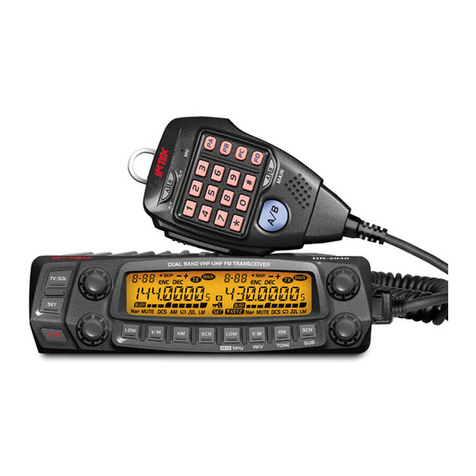
Intek
Intek HR-2040 owner's manual
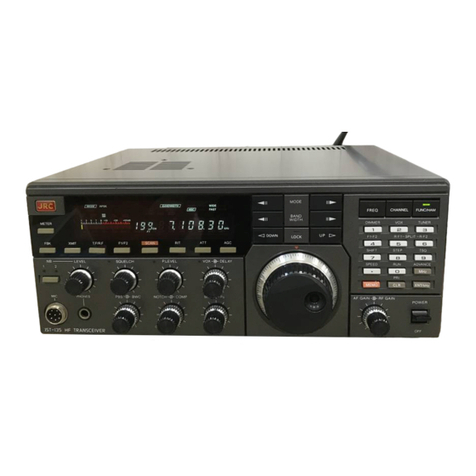
JRC
JRC JST-135 instruction manual

Verterx Standard
Verterx Standard VXA-300 Pilot III operating manual
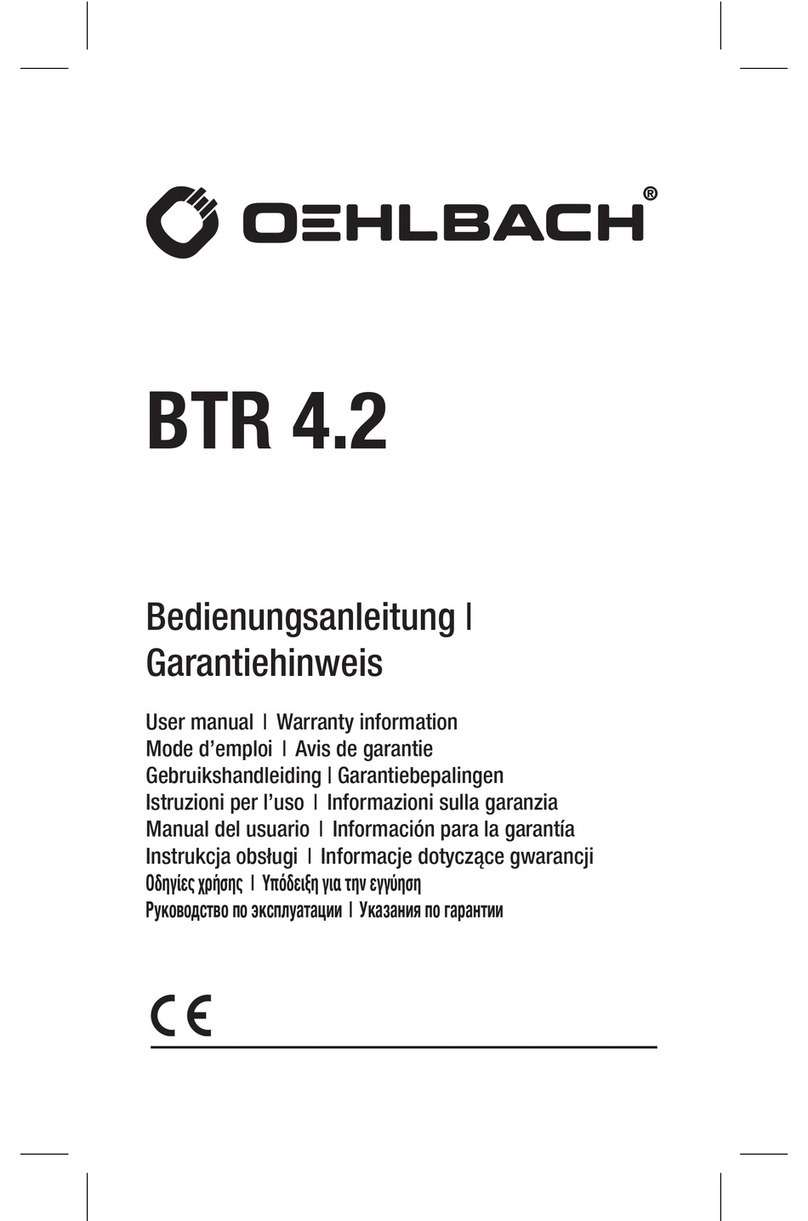
Oehlbach
Oehlbach BTR 4.2 user manual
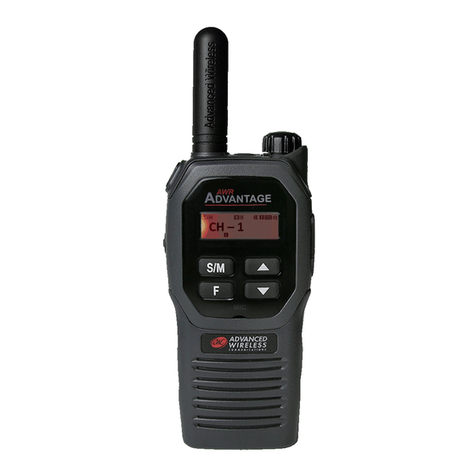
Advanced Wireless Communications
Advanced Wireless Communications AWR Advantage quick start guide
